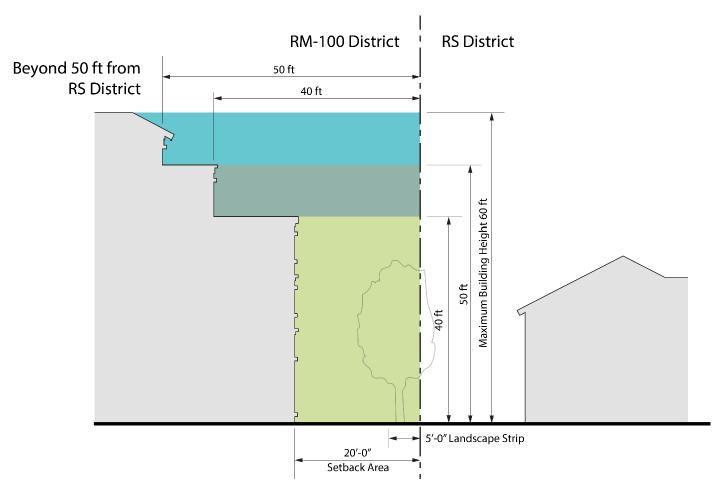Article II: Base and Overlay Districts
Chapter 18.04
RESIDENTIAL DISTRICTS Revised 10/24
Sections:
18.04.020 Land use regulations. Revised 10/24
18.04.030 Development standards—RS districts.
18.04.040 Objective design standards for RS districts.
18.04.050 Development standards—RM districts.
18.04.060 Supplemental regulations—RM districts.
18.04.070 Residential development types.
18.04.090 Townhouse development.
18.04.100 Small lot subdivisions.
18.04.010 Purpose.
The specific purposes of the residential districts are to:
A. Preserve, protect, and enhance the character of the City’s different residential neighborhoods.
B. Ensure adequate light, air, and open space for each dwelling.
C. Ensure that the scale and design of new development and alterations to existing structures are compatible with surrounding homes and appropriate to the physical characteristics of the site and the area where the project is proposed.
D. Provide sites for public and semi-public land uses, such as parks and public safety facilities, that will serve City residents and will complement surrounding residential development.
Additional purposes of each residential district which follow implement General Plan classifications of “Single-Family, 3 du/acre,” “Single-Family, 6 du/acre,” “Multiple-Family, 15—20 du/acre,” “Multiple-Family, 45—59 du/acre,” and “Multiple-Family, 75—100 du/acre.”
E. RS-3 Single-Family. This district is intended for residential densities up to three (3) units per net acre. Development types may include single-unit housing and accessory dwelling units, second single-units pursuant to Government Code Sections 65852.21 and 66411.7 (“urban infill units”), duplexes, and small lot subdivisions. In addition to single-unit homes, this district provides for uses such as small and large family child care, park and recreation facilities, and community gardens that may be appropriate in a single-family residential neighborhood.
F. RS-6 Single-Family. This district is intended for residential densities up to six (6) units per net acre. Development types may include single-unit housing, accessory dwelling units, second single-units pursuant to Government Code Sections 65852.21 and 66411.7 (“urban infill units”), duplexes, townhomes, and small lot subdivisions. This district also allows for uses such as small and large family child care, park and recreation facilities, and civic and institutional uses such as schools and places for community assembly that may be appropriate in a single-family residential neighborhood.
G. RM-20 Multiple-Family. This district is intended for residential densities of up to twenty (20) units per net acre developed at a scale and form that is appropriate to its neighborhood context and adjacent uses. Dwelling types include small lot single-unit development, bungalow courts, front or rear loaded townhomes, multi-unit buildings, and accessory dwelling units. This district also allows for limited uses such as small and large family day care, park and recreation facilities, and civic and institutional uses such as schools and places for community assembly that are appropriate in a low density multifamily residential environment.
H. RM-59 Multiple-Family. This district is intended for residential development at densities up to fifty-nine (59) units per net acre. This density range accommodates townhomes and multi-unit buildings developed at a scale and form that is appropriate to its neighborhood context and adjacent single-family residential uses and forms. Small lot single-unit and bungalow court development is allowed where site conditions exist rendering the development type equal to or better than multi-unit or townhome development. Accessory dwelling units are also permitted in this district. In addition to residential uses, this district allows for a limited number of public and semi-public uses such as day care centers, public safety facilities, and residential care facilities that are appropriate in a medium density multifamily residential environment.
I. RM-100 Multiple-Family. This district is intended for residential development at densities up to one hundred (100) units per net acre. This density range accommodates townhomes and multi-unit buildings developed at a scale and form that exemplifies high quality development. Accessory dwelling units are also permitted in this district. In addition to residential uses, this district allows for a limited number of public and semi-public uses such as day care centers, public safety facilities, and residential care facilities that are appropriate in a high density multifamily residential environment. (Ord. 1603 § 3 (Exh. A), 2023; Ord. 1596 § 6 (Exh. A), 2023; Ord. 1568 § 1 (Exh. A), 2021; Ord. 1566 (Exh. B (part)), 2020: Ord. 1537 (Exh. B (part)), 2018: Ord. 1480 (Exh. B (part)), 2015: Ord. 1438 § 4 (Exh. A (part)), 2011)
18.04.020 Land use regulations. Revised 10/24
Table 18.04.020 prescribes the land use regulations for residential districts. The regulations for each district are established by letter designations as follows:
“P” designates permitted uses.
“M” designates use classifications that are permitted after review and approval of a minor use permit by the Zoning Administrator.
“C” designates use classifications that are permitted after review and approval of a conditional use permit by the Planning and Transportation Commission.
“(#)” numbers in parentheses refer to specific limitations listed at the end of the table.
“-” designates uses that are not permitted.
Use classifications are defined in Chapter 18.40, Use Classifications. In cases where a specific land use or activity is not defined, the Director shall assign the land use or activity to a classification that is substantially similar in character. Use classifications and subclassifications not listed in the table or not found to be substantially similar to the uses below are prohibited. The table also notes additional use regulations that apply to various uses. Section numbers in the right-hand column refer to other sections of this title.
|
Use Classification |
RS-3 |
RS-6 |
RM-20 |
RM-59 |
RM-100 |
Additional Regulations |
|---|---|---|---|---|---|---|
|
Residential Uses |
||||||
|
Residential Housing Types |
See subclassifications below |
|||||
|
Single-Unit Dwelling |
P |
P |
- |
- |
- |
See Section 18.04.100, Small lot subdivision standards See Section 18.04.070, Residential development types See Section 18.04.080, Duplex standards See Section 18.04.090, Townhouse standards *For townhouse development in RM districts, Development Standards of RM District shall apply |
|
Small Lot Single-Unit Subdivision Development |
C (1) |
C (1) |
P |
C (2) |
C (2) |
|
|
Accessory Dwelling Unit |
P |
P |
P |
P |
P |
|
|
Junior Accessory Dwelling Unit |
P |
P |
- |
- |
- |
|
|
Duplex |
P |
P |
P |
- |
- |
|
|
Urban Infill Units |
P |
P |
- |
- |
- |
|
|
Townhouse Development |
- |
C |
P* |
P* |
P* |
|
|
Multi-Unit Residential |
- |
- |
P |
P |
P |
|
|
Elderly and Long-Term Care |
- |
- |
- |
C |
C |
|
|
Family Day Care |
See subclassifications below |
|||||
|
Small |
P |
P |
P |
P |
P |
|
|
Large |
P |
P |
P |
P |
P |
|
|
Group Residential |
- |
- |
- |
P |
P |
|
|
Residential Care Facilities |
See subclassifications below |
|||||
|
General |
- |
- |
M |
M |
M |
See Section 18.23.200, Residential care facilities |
|
Limited |
P |
P |
P |
P |
P |
|
|
Senior |
- |
- |
M |
M |
M |
See Section 18.23.200, Residential care facilities |
|
Single Room Occupancy |
- |
- |
C |
C |
C |
See Section 18.23.220, Single room occupancy hotels |
|
Transitional Housing |
P |
P |
P |
P |
P |
See Section 18.23.250, Transitional and supportive housing |
|
Supportive Housing |
P |
P |
P |
P |
P |
See Section 18.23.250, Transitional and supportive housing |
|
Public and Semi-Public Uses |
||||||
|
Community Assembly |
- |
C |
- |
C |
C |
See Section 18.23.080, Community assembly facilities |
|
Community Garden |
P |
P |
P |
P |
P |
|
|
Cultural Institution |
- |
C |
- |
C |
C |
|
|
Day Care Centers |
P* |
P* |
P* |
P |
P |
See Section 18.23.090, Day care * Permitted only when in an existing building built for and/or previously operated as a legally established public or semi-public use. |
|
Park and Recreation Facilities, Public |
P |
P |
P |
P |
P |
|
|
Public Safety Facilities |
- |
C |
C |
C |
C |
|
|
Schools, Public or Private |
- |
C |
C |
C |
C |
|
|
Social Service Facilities |
- |
- |
- |
M |
M |
|
|
Commercial Uses |
||||||
|
Eating and Drinking Establishments, Convenience |
- |
C(3) |
- |
- |
- |
See Section 18.23.140, Outdoor dining |
|
Retail Sales, Convenience Markets |
- |
C(3) |
- |
- |
- |
|
|
Transportation, Communication, and Utilities Uses |
||||||
|
Communication Facilities |
See Chapter 18.24, Wireless Telecommunications Facilities |
|||||
|
Utilities, Minor |
P |
P |
P |
P |
P |
|
|
Other Applicable Types |
||||||
|
Accessory Uses and Structures |
See Sections 18.15.020, Accessory buildings and structures, and 18.23.030, Accessory uses |
|||||
|
Home Occupations |
P |
P |
P |
P |
P |
See Section 18.23.120, Home occupations |
|
Nonconforming Use |
Chapter 18.19, Nonconforming Uses, Structures, and Lots |
|||||
|
Temporary Use |
See Section 18.23.240, Temporary uses |
|||||
Specific Limitations:
1. In addition to standard use permit findings, the Planning and Transportation Commission must find that the development is designed with massing and height that is sensitive to the building pattern of the area and adjacent properties.
2. In addition to standard use permit findings, the Planning and Transportation Commission must find that specific site conditions exist such that the proposed development type is equal to or better than multi-unit residential or townhouse development types with regard to design and achievable density and the project is designed with massing and height that is sensitive to the building pattern of the area and adjacent properties.
3. Subject to the following limitations:
a. Limited to cafes, coffee shops, delis, and neighborhood markets. Full service restaurants are not allowed.
b. Limited to one thousand five hundred (1,500) square feet of sales area.
c. Hours of operation are limited to between seven (7) a.m. and nine (9) p.m.
d. Must be located within a two (2) story building.
e. Must be located on a corner lot with frontage on an arterial a minimum of one-half (1/2) mile from the MU-DC-100, MU-D-100 and MU-D-120 districts and other existing neighborhood-serving retail.
f. In addition to the findings required for all use permits, the Planning and Transportation Commission must find that the proposed use promotes community health, interaction, and socialization of the neighborhood; complements the residential character of the surrounding neighborhood; and will not adversely impact adjacent properties.
(Ord. 1619 § 4 (Exh. A), 2024; Ord. 1603 § 3 (Exh. A), 2023; Ord. 1596 § 6 (Exh. A), 2023; Ord. 1568 § 1 (Exh. A), 2021; Ord. 1566 (Exh. B (part)), 2020; Ord. 1537 (Exh. B (part)), 2018: Ord. 1480 (Exh. B (part)), 2015; Ord. 1438 § 4 (Exh. A (part)), 2011)
18.04.030 Development standards—RS districts.
A. Table 18.04.030 prescribes the development standards for RS districts. Additional regulations are denoted in a right-hand column. Section numbers in this column refer to other sections of this title, while individual letters refer to subsections that directly follow the table. The numbers in each illustration below refer to corresponding regulations in the “#” column in the associated table.
B. Deviation From Standards.
1. The standards set forth in this section shall apply to all residential development applications in the RS district. Proposed development projects that comply with all development and objective standards contained in this section shall qualify for approval as a matter of right, and subject only to zoning clearance review pursuant to Chapters 18.28 (Zoning Clearance) and 18.29 (Design Review and Objective Design Standards Compliance Review) unless as specified within Table 18.04.020, Land Use Regulations—Residential Districts. For proposed projects that deviate from one (1) or more objective standards, such applications shall be subject to the design review provisions set forth in Chapter 18.29.
2. Deviations Subject to Design Review. Any application involving a deviation or exception from the objective standards for the following shall be subject to design review for that standard pursuant to Chapter 18.29:
a. Building articulation and massing.
b. Building materials and colors.
c. Building modification to preserve a protected tree unless a setback modification requires a variance.
d. Driveway location, width, and configuration.
e. Entry location, connectivity, and treatments.
f. Garage location and setbacks.
g. Landscape design.
h. Roof form and detail.
i. Window treatments.

|
District |
RS-3 |
RS-6 |
Additional Regulations |
# |
|---|---|---|---|---|
|
Lot and Density Standards |
||||
|
Maximum Density (units/net acre) |
3 |
6 |
|
|
|
Minimum Lot Size (sq. ft.) |
10,000* |
5,000* |
*New subdivision lots shall be subject to Table 17.16.030 |
|
|
Corner Lots |
10,000* |
6,000* |
*New subdivision lots shall be subject to Table 17.16.030 |
|
|
Minimum Lot Width (ft.) |
75* |
40* |
*New subdivision lots shall be subject to Table 17.16.030 |
1 |
|
Corner Lots |
75* |
60* |
*New subdivision lots shall be subject to Table 17.16.030 |
2 |
|
Maximum Floor Area |
||||
|
Maximum Floor Area (MFA) |
No MFA |
For lots less than or equal to 7,500 sq. ft. MFA is the greater of 1,100 sq. ft. + 35% of the lot area or 50% of the lot area; for lots greater than 7,500 sq. ft. MFA is 50% of the lot area. |
See Chapter 18.03, Rules of Measurement; See Section 18.23.210 for accessory dwelling unit and junior accessory dwelling unit standards |
|
|
Building Form and Location |
||||
|
Maximum Height (ft.) |
28 (C) |
28 (C) |
See Section 18.15.060, Height and height exceptions, and see Chapter 18.12 for permissible height within a Hillside Overlay District |
3 |
|
Public and Semi-Public Uses |
28 |
45 |
|
|
|
Minimum Setbacks (ft.) |
||||
|
Front |
20 |
1st Story: 15 2nd Story: 19 |
See Section 18.15.080, Projections into yards |
4 |
|
Interior Side |
1st Story: 10 2nd Story: 14 (E, F, G) |
1st Story: 5 (D) 2nd Story: 9 (E, F, G) |
5 |
|
|
Street Side |
1st Story: 10 (G) 2nd Story: 14 (E, F, G) |
1st Story: 7.5 (G) 2nd Story: 11.5 (E, F, G) |
6 |
|
|
Rear |
20 |
15 |
|
7 |
|
Garage, from property line |
20 |
20 |
See Section 18.04.040(A)(3)(d) and (e) Detached garages and see Chapter 18.12 for Hillside Overlay District provisions |
8 |
|
Garage, from primary facade |
5 |
5 |
|
9 |
|
Maximum Lot Coverage (Percent of Lot) |
25 in H Overlay 35 outside H Overlay |
50 |
See Chapter 18.03, Rules of Measurement |
10 |
C. Building Height Within the Front and Rear Fifteen (15) Feet of the Building. The maximum height within the front and rear fifteen (15) feet of the building shall be measured as indicated in Section 18.03.050 (Measuring height) not exceeding twenty-eight (28) feet. For buildings located in the Hillside Overlay zoning district, refer to Chapter 18.12 (Hillside Overlay District).
FIGURE 18.04.030-C: MEASURING BUILDING HEIGHT—RS DISTRICTS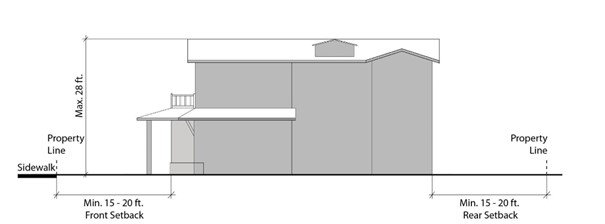
D. Side Setback Exception. For lots less than fifty (50) feet in width, the minimum ground-floor side setback shall be a minimum of ten percent (10%) of the lot width or three (3) feet, whichever is greater.
E. The upper story may align with the lower story at the required lower story five (5) feet setback for up to thirty percent (30%) of the length of the lower story. The maximum thirty percent (30%) projection shall be measured from the rear wall of the lower story. Any window located on the projecting portion of the building shall be either a clerestory window or shall be glazed, tinted, etched, frosted, or treated in any similar manner that limits views into and from the window.
FIGURE 18.04.030-E: SECOND STORY PROJECTION
FIGURE 18.04.030-F, G: SEVEN (7) FEET INTERIOR SIDE SETBACK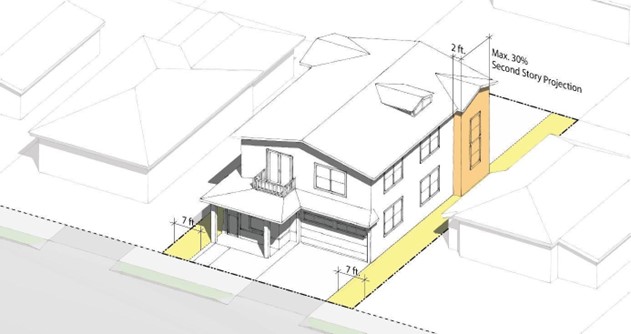
F. Where the entire ground floor is set back at least seven (7) feet from the property line, the upper story may align with the lower story for the entire length of the building.
G. For a ground floor setback of seven (7) feet a projection of up to two (2) feet is allowed on the lower and upper story. The alignment of the stories shall not exceed thirty percent (30%) of the length of the lower story. The maximum thirty percent (30%) projection shall be measured from the rear wall of the lower story. Any window located on the projecting portion of the building shall be either a clerestory window or shall be glazed, tinted, etched, frosted, or treated in any similar manner that limits views into and from the window.
H. Street Side Setbacks on Lots with Reversed Frontage. The exterior side setback in the rear twenty-five percent (25%) of a reversed corner lot shall not be less than the front yard required or existing, whichever is less, on the adjoining key lot.
FIGURE 18.04.030-H: STREET SIDE SETBACKS ON LOTS WITH REVERSED FRONTAGE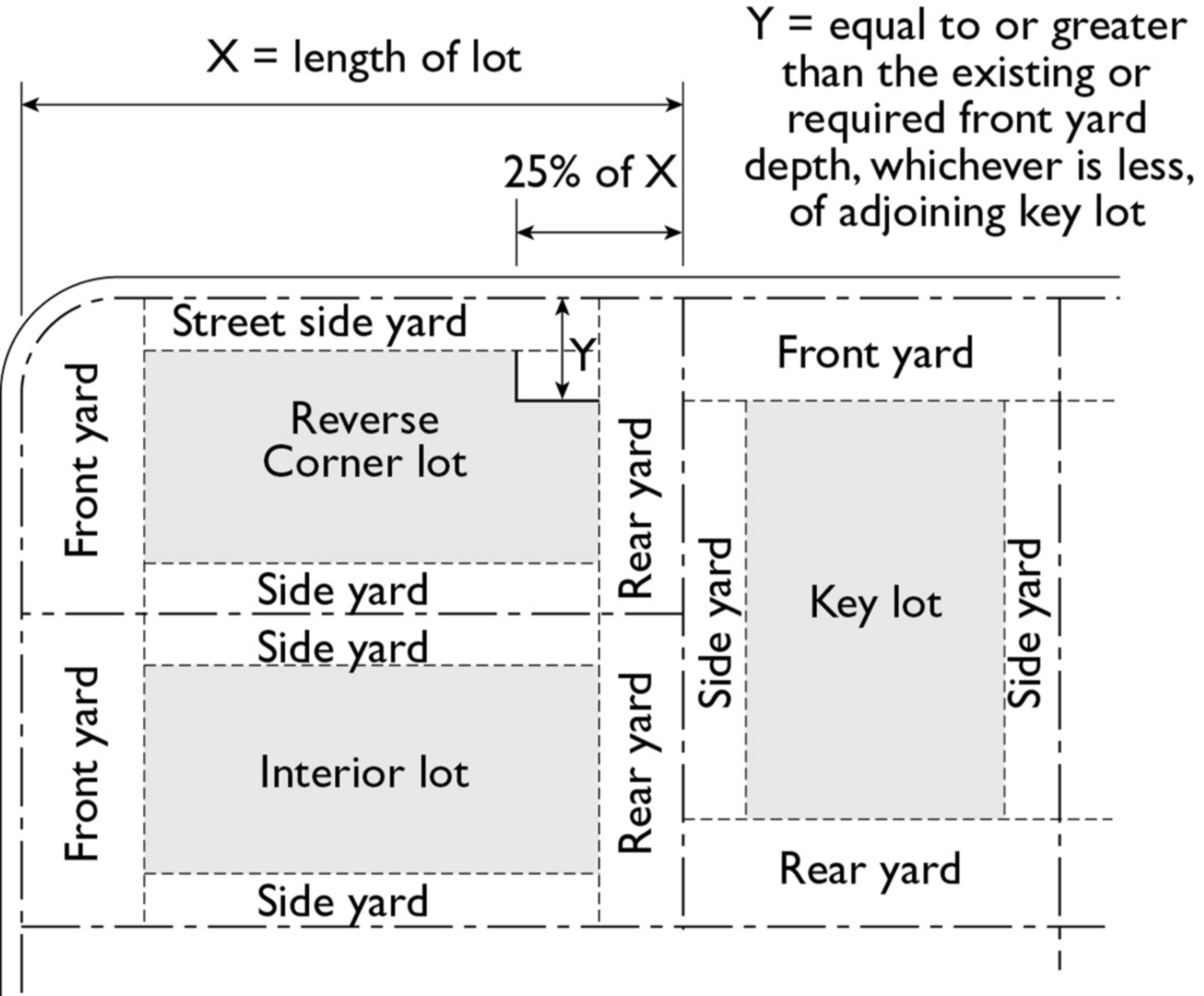
(Ord. 1603 § 3 (Exh. A), 2023; Ord. 1596 § 6 (Exh. A), 2023; Ord. 1566 (Exh. B (part)), 2020; Ord. 1537 (Exh. B (part)), 2018: Ord. 1480 (Exh. B (part)), 2015; Ord. 1438 § 4 (Exh. A (part)), 2011)
18.04.040 Objective design standards for RS districts.
A. Site Planning.
1. Entry Location and Street Connectivity.
a. Entry Location. The principal entry for all new primary units shall be located and oriented to face the adjacent public or private street.
b. Street Connectivity.
i. A separate walkway measuring minimum thirty-six (36) inches in width shall be provided from the sidewalk to the primary entry.
ii. The driveway shall not serve as the primary walkway to the building entry.
iii. The primary walkway shall be differentiated from the driveway with the use of paving materials. Differentiated paving materials may include but are not limited to pavers, stepping stones, flagstones, or gravel.
FIGURE 18.04.040-A(1): ENTRY LOCATION AND STREET CONNECTIVITY—RS DISTRICTS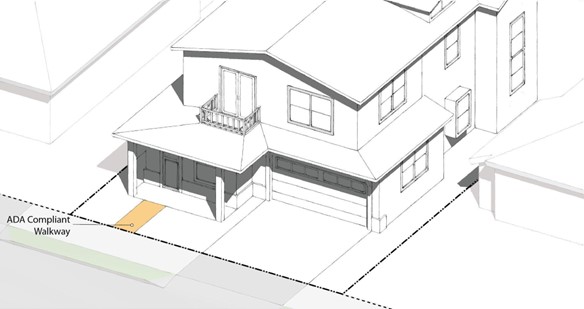
2. Parking and Driveways.
a. Parking/Garage Access. Parking spaces shall be provided as required by Chapter 18.20 (Parking and Loading).
b. Driveways.
i. Driveway approaches (curb cuts) shall be permitted only to provide access to approved garages, carports, and parking spaces.
ii. Curb cuts are permitted pursuant to Chapter 12.04 (Sidewalk and Driveway Approach Construction and Repair).
iii. Driveways up to twenty (20) feet wide are permitted to serve the primary unit.
iv. Tandem parking configurations are permitted when only a single-car garage is proposed or existing. The driveway shall be a maximum of ten (10) feet wide and a maximum of thirty-eight (38) feet in length.
v. Driveways serving two (2) or more units shall be the minimum width required by the City Engineer per Sections 12.04.090, 12.04.100 and 18.20.100.
vi. Driveways abutting a side property line shall include a minimum two (2) foot wide pervious surface edge treatment along that abutting property line.
vii. Driveways must be distinguished with a use of different color or material than the adjacent material in the front setback area.
viii. Driveways on corner lots shall be located at least twenty (20) feet from the property lines at the intersection corner.
FIGURE 18.04.040-A(2): PARKING AND DRIVEWAY—RS DISTRICTS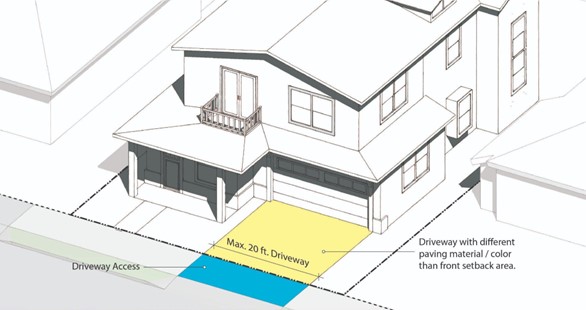
3. Garage Frontage.
a. Where a garage is located on the front half of the lot and the garage door faces a street and the lot width is sixty (60) feet or less, the garage frontage including the door width shall not exceed fifty percent (50%) of the width of the front facade of the building. For lots wider than sixty (60) feet, the garage facade including the door shall not exceed forty percent (40%) of the front facade of the building.
FIGURE 18.04.040-A(3)(a): DRIVEWAY ON CORNER LOTS—RS DISTRICTS
b. Garage doors facing the street shall have articulating elements consisting of at least one (1) of the following design elements on the facade:
i. An overhang of at least eighteen (18) inches in depth.
ii. Windows.
iii. Have the garage doors use colors or materials that are in the same color family as those of the primary building facade.
iv. Decorative trellis.
FIGURE 18.04.040-A(3)(b): GARAGE FRONTAGE STANDARDS—RS DISTRICTS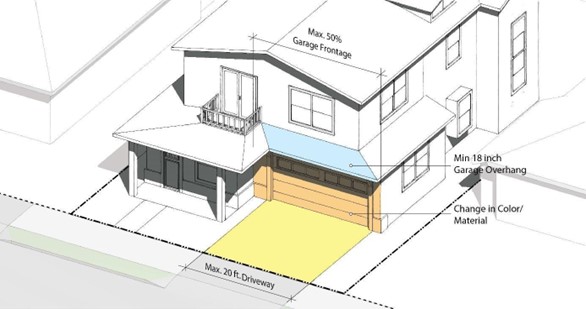
c. Side-loaded garages may be used to diminish the impact of garages along the street frontage. The use of at least one (1) of the following design elements is required to avoid the blank wall of the garage.
i. Landscaping with a mature height of at least twenty-four (24) inches.
ii. Raised planters with a minimum height of twelve (12) inches and landscaping with a mature height of at least twelve (12) inches.
iii. Windows.
iv. Decorative trellis.
v. Material change relative to materials used for the building.
d. Detached Garages. Detached garages shall have a minimum setback of three (3) feet from a property line and (4) feet from an alley.
e. Alley Access. A detached garage or carport is permitted to have access to the alley if all following conditions are achieved:
i. The garage or carport entrance shall be set back a minimum of four (4) feet from the alley;
ii. A forty-five (45) degree visibility triangle shall be provided on either side of the garage or carport; and
iii. The garage door does not cross the property line when opening or closing.
FIGURE 18.04.040-A(3)(e): ALLEY ACCESS—RS DISTRICTS
B. Building Design.
1. Massing. The purpose of regulating building mass is to ensure a building fits well on a site, respects the scale of the neighborhood, and avoids bulky appearance. Building walls and the massing of the structure shall not run in a continuous plane of more than twenty-five (25) feet without one (1) or more of the following treatments:
a. Incorporate a change in wall plane with a minimum of four (4) feet in depth for the facade.
b. Provide a recessed entry of at least three (3) feet in depth.
c. Provide a protruding window (such as a bay window) of at least two (2) feet in depth.
d. Use at least two (2) distinct materials and colors on each facade (see subsection (B)(8) of this section, Materials).
e. Provide an upper story balcony in the front step back area.
FIGURE 18.04.040-B(1): BUILDING MASSING—RS DISTRICTS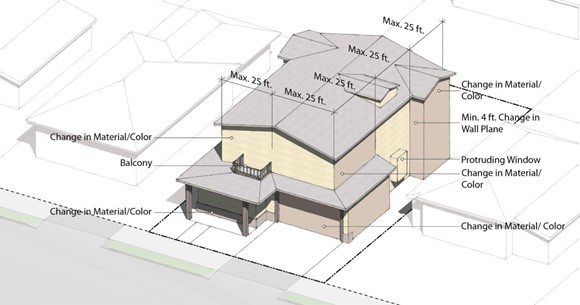
2. Articulation. The purpose of regulating articulation is to avoid flat, blank walls that may result from massing requirements as indicated within the building design subsection and to create a visual interest to enhance the character of the neighborhood. The following regulations apply:
a. No facade shall run in a continuous plane of more than fifteen (15) feet without one (1) of the following treatments included on the facade at every building story:
i. Window.
ii. Entry door.
iii. Change in material (see subsection (B)(8) of this section, Materials).
iv. Decorative shutters.
v. Trellis.
FIGURE 18.04.040-B(2): BUILDING ARTICULATION—RS DISTRICTS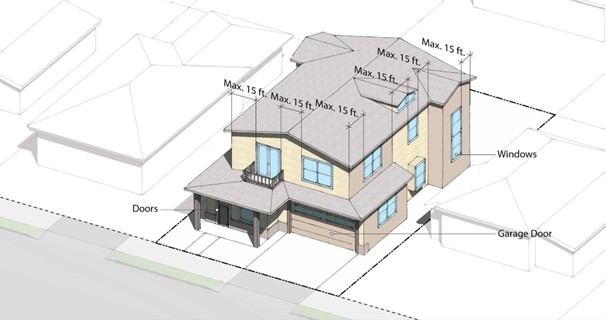
b. Balconies.
i. Usable balconies shall not be located on any facade facing a side yard. Juliette/French balconies may be used as an accent feature on side yard facades, provided such balconies have a projection of no more than eighteen (18) inches.
ii. Projected and/or recessed balconies shall be at least four (4) feet deep and six (6) feet wide.
iii. Projected and/or recessed balconies located on rear facades shall not be located within fifteen (15) feet from any interior side property line.
iv. Projected and/or recessed balconies shall incorporate screening features that obstruct views into neighboring yards. Screening may be accomplished by architectural methods or by providing landscape screening along side-yard property lines. If landscape screening is provided without supporting elements, it shall comprise woody shrubs or trees that are at least fifteen (15) feet in height at installation and that will be less than eight (8) feet wide at maturity.
v. Projected balconies located on rear facades shall not encroach more than five (5) feet into the rear setback.
FIGURE 18.04.040-B(2)(b): BALCONY LOCATION FROM INTERIOR PROPERTY LINE—RS DISTRICTS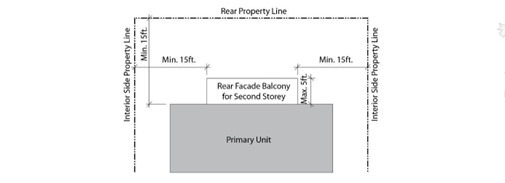
3. Ground Floor Entryways. All units shall have an entryway defined by at least one (1) of the following elements with:
a. Porch.
b. Recessed entry.
c. Deep overhang.
4. Ground Floor Entryway Treatments. Entryways shall be a characteristic component of the selected architectural style unless otherwise specified in the reference guide. The following standards shall apply:
a. Porch Design.
i. The front porch shall be part of the primary entrance and connected to the front yard.
ii. Porches shall have a minimum depth of three (3) feet for up to thirty (30) square feet.
iii. Porches shall not encroach more than five (5) feet into the front setback.
iv. Porches shall not exceed ten (10) feet in height measured from the finished grade to the bottom of the eave, not including the roof element.
FIGURE 18.04.040-B(4)(a): PORCH DESIGN—RS DISTRICTS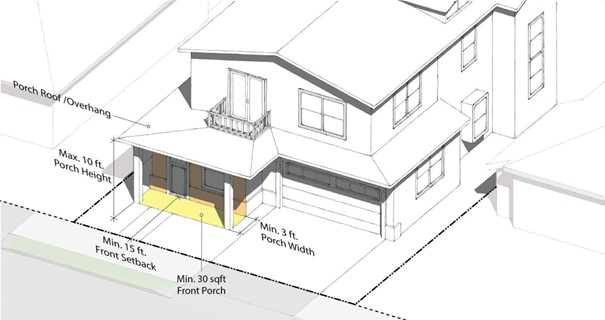
b. Recessed Entry.
i. Recessed entries shall be recessed at least three (3) feet from the building facade to create a covered landing area. The recessed entry shall be oriented towards the street.
FIGURE 18.04.040-B(4)(b): PORCH ENCROACHMENT—RS DISTRICTS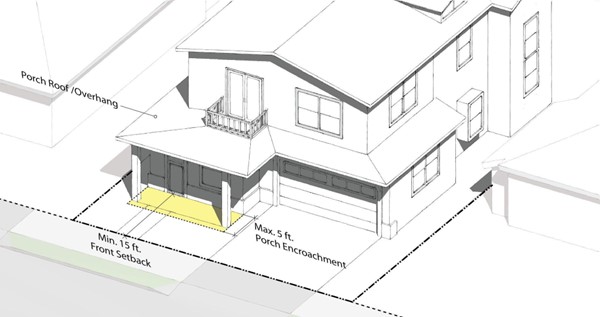
FIGURE 18.04.040-B(4)(b): RECESSED ENTRY—RS DISTRICTS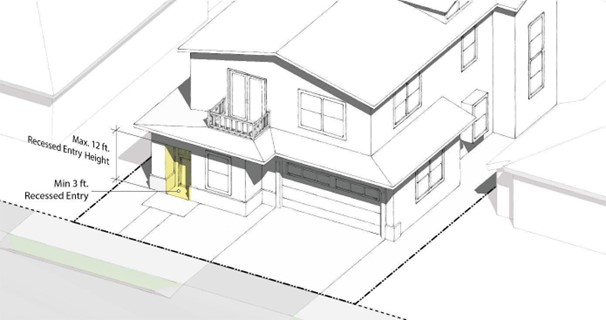
ii. Recessed entries shall not exceed twelve (12) feet in height from floor to ceiling.
c. Deep Overhang.
i. Deep overhangs shall be a minimum depth of three (3) feet and a maximum of five (5) feet.
ii. Deep overhangs shall not exceed twelve (12) feet in height measured from the finished grade to the top of the overhang, not including the roof element.
5. Architectural Style.
a. For the purpose of defining architectural styles as set forth in this section, the reference guide shall be the most currently published version of A Field Guide to American Houses: the Definitive Guide to Identifying and Understanding America’s Domestic Architecture by Virginia Savage McAlester or American House Styles: A Concise Guide by John Milnes Baker, AIA. The City may identify an alternative source or sources, provided such source is made publicly available.
b. Using the building design reference document identified above, projects shall identify an architectural design style and include at least four (4) features in their design consistent with the description of the selected style:
i. Roof type and characteristic pitch (required).
ii. Roof rake, eave overhang, and cornice detail.
iii. Wall facade symmetry or asymmetry and detail.
iv. Wall material and arrangement relative to roof.
v. Window type, relative proportion, shape, and detail.
vi. Door type, relative proportion, shape, and detail.
vii. Porch type, relative proportion, shape, and detail.
6. Roof Treatments.
a. Roof Form. Rooflines that are thirty (30) feet or longer along a street-facing property line and greater than fifty (50) linear feet for all other sides shall be articulated with at least one (1) of the following techniques:
i. Change in the roof ridge.
ii. Change in the shape of the roof.
iii. Change in the angle of the slope.
iv. Change in the eave depth.
v. Change in detailing in the form of dormers.
vi. Change in the detailing in the form of skylights.
FIGURE 18.04.040-B(6)(a): ROOF FORM AND DETAILS—RS DISTRICTS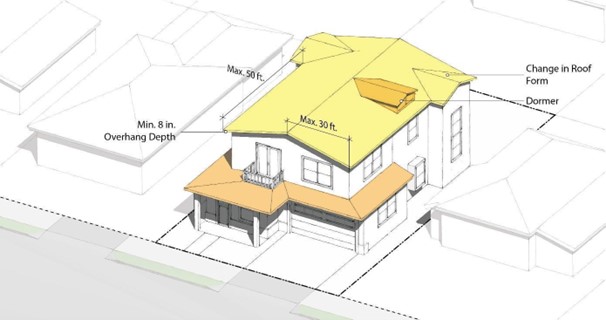
b. Roof form articulation shall allow an exception where solar panels are to be provided. The applicant shall be required to provide documentation from a qualified designer or contractor citing specific building code requirements that necessitate the exception.
c. Roof Form Detail.
i. Sloped roofs shall incorporate a minimum of eight (8) inch deep eaves to create shadows and add depth to facades. If a particular style based on the architectural style subsection has a roof or eave style that is different from this standard, this standard shall not apply.
ii. Flat roofs, when used, shall incorporate a decorative cornice consistent with the architectural style as specified in architectural style subsection and shall visually cap the building at a minimum of three (3) inches deep and twelve (12) inches tall.
d. Rooftop Utilities and Equipment. Rooftop utilities and equipment shall be screened by a parapet or mansard roof so that such equipment is not visible from the public right-of-way.
FIGURE 18.04.040-B(6)(d): FLAT ROOF FORM AND DETAILS—RS DISTRICTS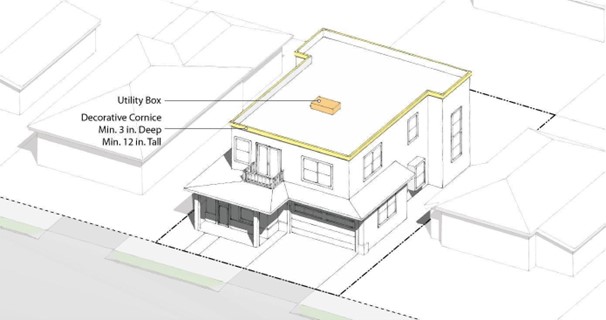
7. Windows.
a. Window Detail.
i. Window Trim or Recess. Trim at least one (1) inch in depth must be provided around all windows, or window must be recessed at least two (2) inches from the plane of the surrounding exterior wall. For double-hung and horizontal sliding windows, at least one (1) sash shall achieve a two (2) inch recess.
ii. Windows. Snap-in vinyl mullions between double pane glass are prohibited. If a divided light appearance is desired, mullions must be made of dimensional material projecting in front of the panes on both the inside and outside of the window. Exceptions may be granted through the design review process to accommodate alternative window design complementary to the architectural style of the structure.
FIGURE 18.04.040-B(7): WINDOW TRIM OR RECESS—RS DISTRICTS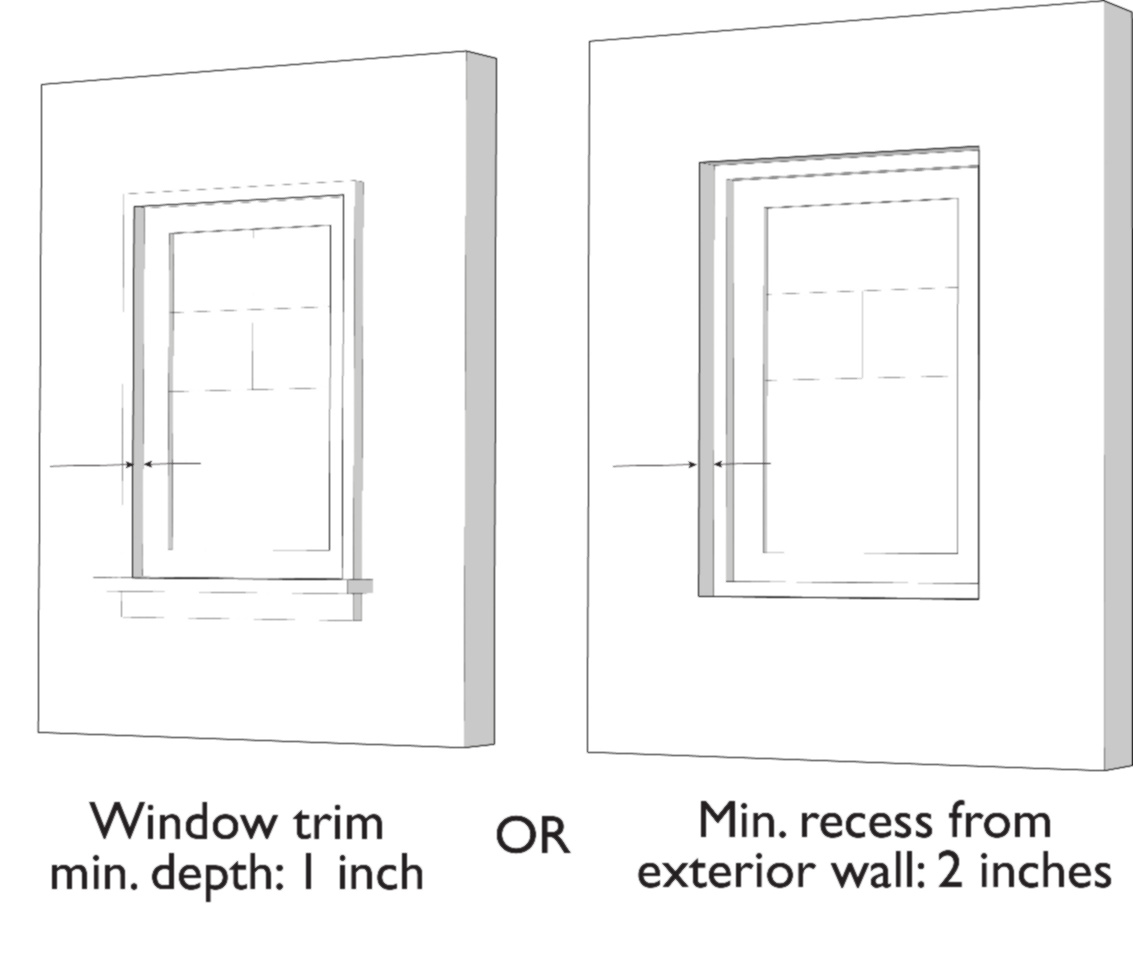
8. Materials.
a. At a minimum, at least three (3) materials or color shall be used consistently on the entire building facade and shall consist of materials appropriate to the selected architectural style (per architectural style reference guide) of the building. Roof and glazing material or color are excluded and do not count towards this requirement. The following building elements with materials and colors count towards this requirement:
i. Main building.
ii. Wainscoting.
iii. Trim work.
iv. Exterior doors.
v. Garage doors.
vi. Decorative elements including trellis, iron work, planter boxes, etc., each with a minimum of ten (10) square feet in surface area.
FIGURE 18.04.040-B(8): MATERIALS—RS DISTRICTS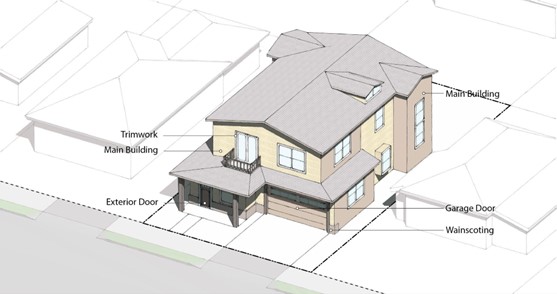
b. Where an exterior wainscoting is provided, such wainscoting shall have a minimum height of eighteen (18) inches from the finished grade. Wainscoting shall not end at the corner of the building but shall wrap around and continue at least eighteen (18) inches to provide a finished appearance.
c. The exterior use of porous materials, foam for trims, plastic, and plywood as siding materials is prohibited.
d. The Planning Director shall maintain a list of approved facade and trim materials, with such list accessible to the public.
C. Other Details.
1. Landscape Design. The following standards are supplemental to the standards contained in Chapter 18.18 (Landscaping). Where conflicts exist, the stricter standard shall prevail.
a. Front Yard Landscaping.
i. Within the required front yard area, impervious surfaces shall not exceed fifty percent (50%).
ii. At least fifty percent (50%) of the required front yard area shall consist of landscape as specified in Chapter 18.18 (Landscaping).
FIGURE 18.04.040-C: LANDSCAPE DESIGN—RS DISTRICTS
b. Front Yard Trees. The number and location of required trees shall be governed as specified in Section 18.18.070 (Trees).
2. Lighting. All exterior lighting shall comply with the provisions of Section 18.15.070 (Lighting and illumination). The following standards are supplemental to the existing standards and where conflicts exist, the stricter standard shall prevail.
a. Location. Any light fixture located along the pathways shall not obstruct ADA path of travel.
b. Brightness. Shall not exceed four hundred fifty (450) lumens per light fixture (equivalent to thirty (30) watt halogen light bulb) and should not exceed five (5) foot-candles in any given spot.
c. Direction. For freestanding light fixtures, the light elements shall be screened to minimize light spillage and confine light to the site and directed away from neighbors.
i. All outdoor lighting, including in-ground-lighting and parking area lights, shall be located and directed away from windows of residential units to reduce light impact on residents. Such lighting shall be directed downward and away from adjacent residences and public right-of-way.
ii. To minimize the light glare and spillage, all wall-mounted fixtures shall be oriented to an angle towards the ground. The optimal angle shall be between fifty (50) to seventy (70) degrees.
iii. Bollard lighting used to light walkways and other landscape features shall cast its light downward.
d. Security Lighting. Motion-activated security lighting shall not be capable of being activated by any person(s) in the public right-of-way or on adjacent property.
3. Utilities.
a. All utility screening shall comply with Section 18.15.090 (Screening).
b. Ground-level utilities and mechanical equipment directly serving the primary or secondary units shall not be located within any front yard area.
c. Public utilities equipment, where provided above ground, shall comply with the following:
i. Such equipment shall not be located within any required front setback area.
ii. Such equipment shall be screened using one (1) or more of the following approaches:
(A) Landscaping.
(B) Raised planters’ minimum height of twelve (12) inches with landscape.
(C) Mesh fence for vertical vegetation.
(D) Walls or fencing consistent with the overall architecture of the building. (Ord. 1603 § 3 (Exh. A), 2023; Ord. 1596 § 6 (Exh. A), 2023; Ord. 1537 (Exh. B (part)), 2018: Ord. 1438 § 4 (Exh. A (part)), 2011)
18.04.050 Development standards—RM districts.
Tables 18.04.050-1 and 18.04.050-2 prescribe the development standards for RM districts. Additional regulations are denoted in a right hand column. Section numbers in this column refer to other sections of this title, while individual letters refer to subsections that directly follow the table. The numbers in each illustration below refer to corresponding regulations in the “#” column in the associated table.
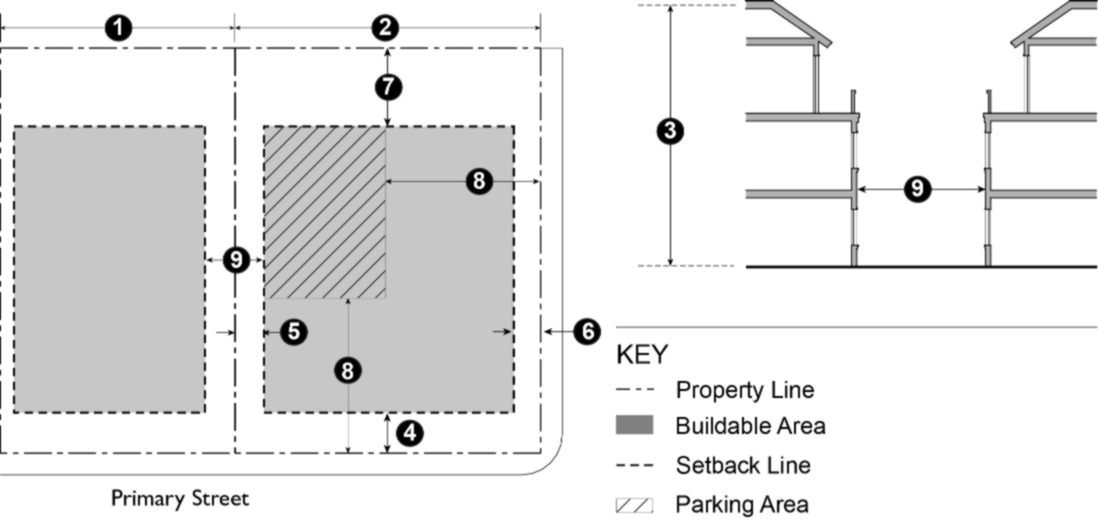
|
District |
RM-20 |
RM-59 |
RM-100 |
Additional Regulations |
# |
|---|---|---|---|---|---|
|
Lot and Density Standards |
|||||
|
Maximum Density (units/net acre) |
20 |
59 |
100 |
|
|
|
Minimum Density (units/net acre)1 |
15 |
45 |
75 |
|
|
|
Minimum Lot Size (sq. ft.) |
6,000 |
10,000 |
10,000 |
|
|
|
Minimum Lot Width (ft.) |
60 |
100 |
100 |
|
1 |
|
Corner Lots |
70 |
100 |
100 |
|
2 |
|
Building Form and Location |
|||||
|
Maximum Height (ft.) |
35 |
50 (A) |
60 (A) |
See Section 18.15.060, Height and height exceptions |
3 |
|
Maximum Stories |
3 |
4 (B) |
5 (B) |
|
|
|
Minimum Setbacks (ft.) |
|||||
|
Front |
15 (C) |
15 (C) |
15 (C) |
|
4 |
|
Interior Side |
5 (A) |
See Section 18.15.080, Projections into required yards |
5 |
||
|
Street Side |
10 (D) |
10 (D) |
10 (D) |
6 |
|
|
Rear |
15 |
15 (A) |
15 (A) |
7 |
|
|
Parking, from Street-Facing Property Line |
40 (E) |
40 (E) |
40 (E) |
8 |
|
|
Maximum Lot Coverage (Percent of Lot) |
65 |
75 |
75 |
See Chapter 18.03, Rules of Measurement |
|
|
Maximum Floor Area Ratio (FAR) |
0.75 |
2.0 |
3.0 |
|
|
|
Maximum Upper Story Massing (Percent of Ground Floor Footprint) |
|||||
|
2nd Story |
100 |
100 |
100 |
Not applicable on lots less than 60 feet wide |
|
|
3rd Story and Above |
80 |
80 |
80 |
|
|
(1) Minimum densities apply to new development and construction of new projects, or when adding residential to an existing commercial use. For wholesale conversion of commercial uses to residential, minimum densities shall apply; but for small conversion of an existing single-space commercial use to residential, minimum densities shall not apply.
|
District |
RM-20 |
RM-59 |
RM-100 |
Additional Regulations |
|---|---|---|---|---|
|
Minimum Common and/or Private Open Space (percent of site area) |
15 |
15 |
10 |
(F) |
|
Minimum Amount of Landscaping (percent of site) |
20 |
15 |
10 |
See Chapter 18.18, Landscaping |
|
Maximum Paving in Street-Facing Yards (percent of required yard) |
50 |
50 |
50 |
|
A. Transitional Standards. Where an RM-59 or RM-100 district is adjacent to an RS district, the following standards apply:
1. For the RM-100 zoning district, the maximum height within forty (40) feet of an RS district is forty (40) feet. The maximum height within fifty (50) feet of an RS district is fifty (50) feet.
2. For the RM-59 zoning district, the maximum height within forty (40) feet of an RS district is thirty (30) feet. The maximum height within fifty (50) feet of an RS district is forty (40) feet.
3. The building setback from an RS district boundary shall be ten (10) feet for interior side yards and twenty (20) feet for rear yards.
4. A landscaped planting area, a minimum of five (5) feet in width, shall be provided along all RS district boundaries. A tree screen shall be planted in this area with trees planted at a minimum interval of fifteen (15) feet.
FIGURES 18.04.050-A: TRANSITIONAL STANDARDS—RM DISTRICTS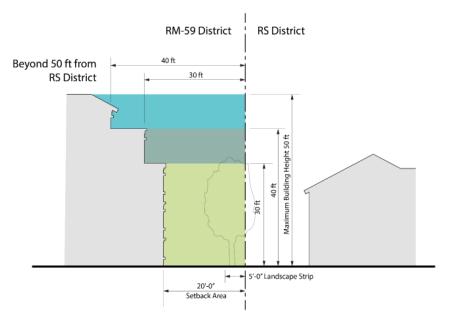
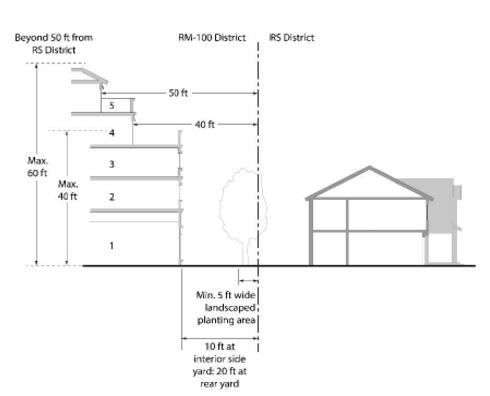
B. Upper Story Stepback. The fourth and fifth story street-facing building frontages shall be stepped back a minimum of ten (10) feet from the stories below. Exceptions may be granted by the Director; provided, that an entry courtyard with a minimum depth of twenty-five (25) feet, landscaping, and seating amenities are provided on the ground level at grade; or other comparable public amenities are provided.
FIGURE 18.04.050-B: UPPER STORY SETBACK
C. Front Setback. Where seventy-five percent (75%) or more of the lots in a block, on both sides of the street, have been improved with buildings, the minimum front setback required shall be the average of improved lots or fifteen (15) feet, whichever is less.
D. Street Side Yards on Lots with Reversed Frontage. The rear one-quarter (1/4) of the exterior side yard shall not be less than the front yard required or existing on the lot adjoining such exterior side yard.
FIGURE 18.04.050-D: STREET SIDE YARDS ON LOTS WITH REVERSED FRONTAGE—RM DISTRICTS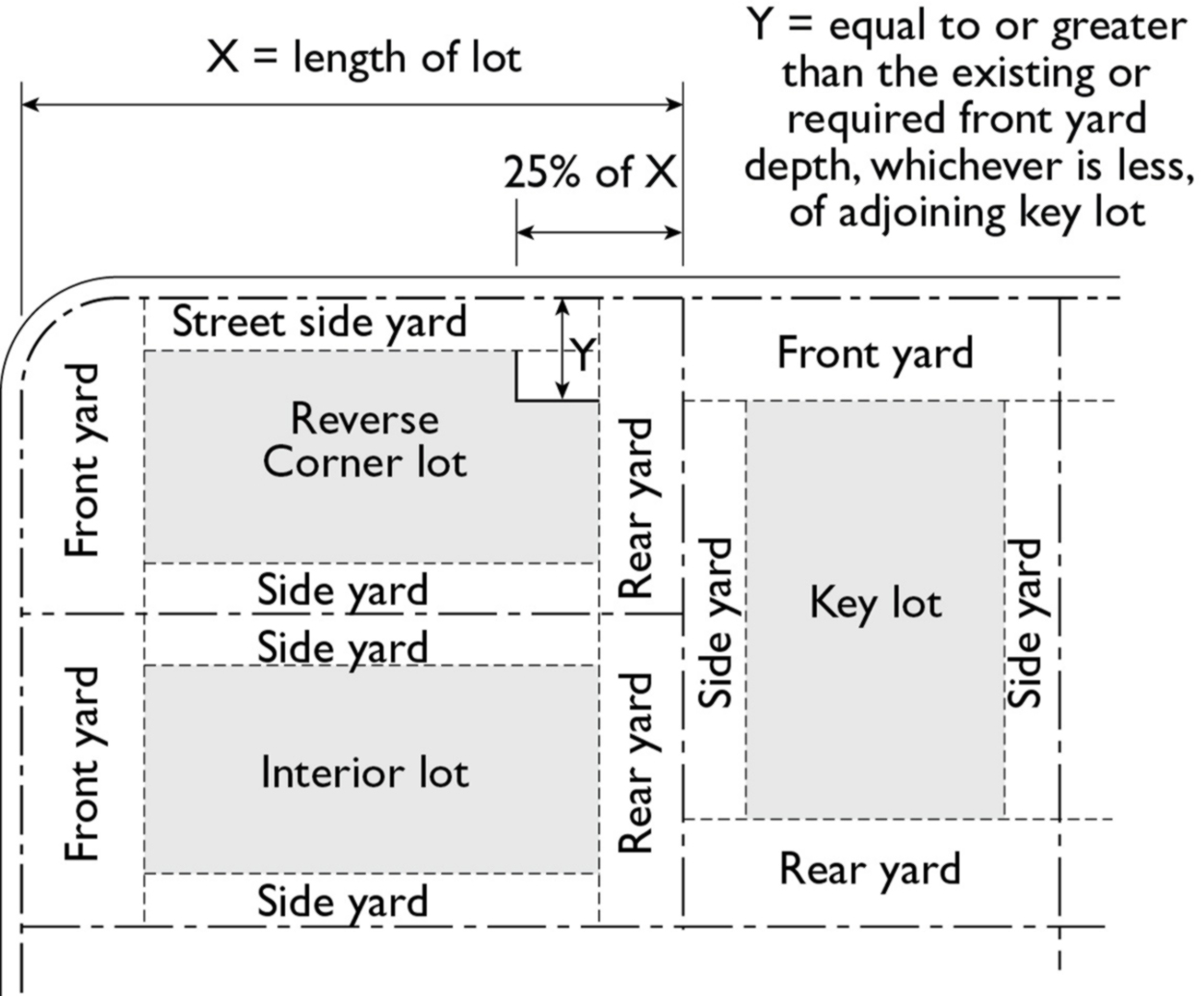
E. Parking Setback. Parking may be located within forty (40) feet of the street-facing property line in accordance with the following standards:
1. Underground and Partially Submerged Parking. Parking completely or partially underground may match the setbacks of the main structure. The maximum height of a parking podium visible from a street is five (5) feet from finished grade.
2. Surface Parking. Above-ground parking may be located within forty (40) feet of a street-facing property line when the decision making authority can make all of the following findings:
a. The design incorporates habitable space built close to the public sidewalk to the maximum extent feasible;
b. The parking area is well screened with a wall, hedge, trellis, and/or landscaping; and
c. The site is small and constrained such that underground, partially submerged, or surface parking located more than forty (40) feet from the street frontage is not feasible.
F. Open Space. Private and common areas shall be provided in accordance with this section. Private areas typically consist of balconies, decks, patios, fenced yards, and other similar areas outside the residence. Common areas typically consist of landscaped areas, walks, patios, swimming pools, barbecue areas, playgrounds, turf, or other such improvements as are appropriate to enhance the outdoor environment of the development. Landscaped courtyard entries that are oriented towards the public street which create a welcoming entry feature are also considered common areas. All areas not improved with buildings, parking, vehicular accessways, trash enclosures, and similar items shall be developed as common areas with the types of attributes described above.
1. Usability. A surface shall be provided that allows convenient use for outdoor living and/or recreation. Such surface may be any practicable combination of lawn, garden, flagstone, wood planking, concrete, or other serviceable, dust-free surfacing. The slope shall not exceed ten percent (10%).
2. Accessibility.
a. Common Open Space. The space shall be accessible to the living units on the lot. It shall be served by any stairway or other accessway qualifying as an egress facility from a habitable room. (Ord. 1596 § 6 (Exh. A), 2023; Ord. 1537 (Exh. B (part)), 2018: Ord. 1480 (Exh. B (part)), 2015; Ord. 1438 § 4 (Exh. A (part)), 2011)
18.04.060 Supplemental regulations—RM districts.
A. Building Entrances.
1. Orientation. All units located along public rights-of-way must have the primary entrance facing this right-of-way. Exceptions to this requirement may be approved for projects where multiple-family housing is located on four (4) lane streets carrying high traffic volumes and/or streets that do not allow on-street parking. In such cases, the project may be oriented around courtyards.
2. Projection or Recess. Building entrances must have a roofed projection (such as a porch) or recess with a minimum depth of at least five (5) feet and a minimum horizontal area of fifty (50) square feet. Alternative designs that create a welcoming entry feature facing the street, such as trellis or landscaped courtyard entry, may be approved by the Director.
3. Dwelling Unit Access. Exterior entrances to units shall be in a form of individual or shared entrances at the ground floor of the building. Unit entrances above the ground floor are also permitted; however, no exterior access corridor located above the ground floor may provide access to five (5) or more units.
B. Building Design. Buildings shall include adequate design features to create visual variety and avoid a large-scale and bulky appearance.
1. Building Length. The maximum dimension of any single building shall not exceed one hundred twenty-five (125) feet.
2. Roof Line. The roof line at each elevation shall demonstrate an offset of at least eighteen (18) inches for each one (1) to three (3) units exposed on that elevation. Large, continuous roof planes are prohibited.
3. Window Trim or Recess. Trim at least one (1) inch in depth must be provided around all windows, or window must be recessed at least two (2) inches from the plane of the surrounding exterior wall. For double-hung and horizontal sliding windows, at least one (1) sash shall achieve a two (2) inch recess. Exceptions may be granted through the design review process to accommodate alternative window design complementary to the architectural style of the structure.
4. Windows. Snap-in vinyl mullions between double pane glass are prohibited. If a divided light appearance is desired, mullions must be made of dimensional material projecting in front of the panes on both the inside and outside of the window.
5. Facade Articulation. All street-facing facades shall have at least one (1) horizontal or vertical projection or recess at least four (4) feet in depth, or two (2) projections or recesses at least two and one-half (2 1/2) feet in depth, for every twenty-five (25) horizontal feet of wall. If located on a building with two (2) or more stories, the articulated elements must be greater than one (1) story in height, and may be grouped rather than evenly spaced in twenty-five (25) foot modules. Building entrances and front porches and projections into required yards such as stoops, bays, overhangs, fireplaces, and trellises may count towards meeting this requirement.
6. Facade Detailing and Materials. All visible building facades shall incorporate details, such as window and door trim, window recesses, cornices, changes in materials or other design elements, in an integrated composition. Each side of a building that is visible from a public right-of-way shall be designed with a complementary level of detailing and quality of materials.
7. Building Colors. Every building shall have at least two (2) complementary colors which demonstrate a harmonious relationship.
8. Building Materials. All materials shall be high quality to allow for long-term durability and appearance. The exterior use of foam for trim and plywood, vinyl or aluminum as siding materials is prohibited.
9. Transition Areas. Where new multifamily developments are built adjacent to existing lower-scaled residential development, the facade facing the existing lower-scaled residential development shall be designed to provide architectural relief and interest, while also respecting the scale of adjacent neighbors.
a. Height. Full-height recesses, a minimum of ten (10) feet deep, shall be provided along the facade to break the building into smaller discrete masses.
FIGURE 18.04.060-B(8)(a): MINIMUM RECESS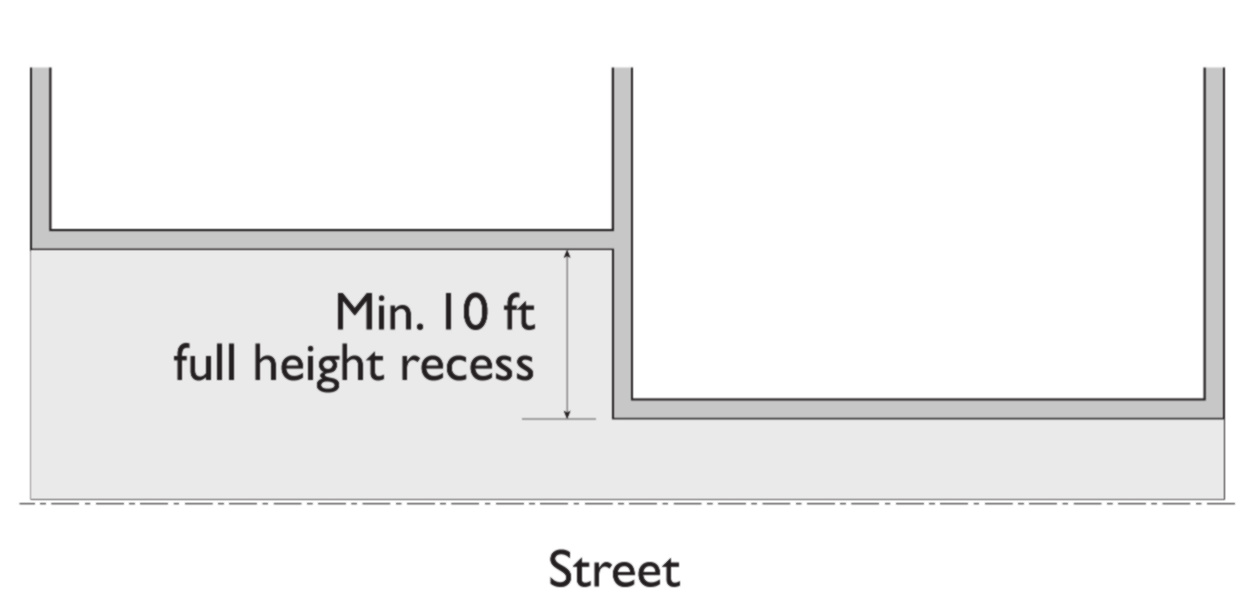
b. Window and Balcony Placement. Offset windows to avoid direct sight lines into and from neighboring properties. Position balconies and other private open space so they minimize views into neighboring properties.
10. Exceptions. Exceptions to the building design standards may be granted with approval of a conditional use permit based on the finding that adequate design features have been incorporated to create visual variety and avoid a large-scale, bulky, or monolithic appearance.
C. Private Storage Space. Each unit shall have at least two hundred (200) cubic feet of enclosed, weather-proofed, and lockable private storage space with a minimum horizontal dimension of four (4) feet.
D. Paving. Differentiated paving materials shall be used for garage aprons, entries, and pedestrian walkways. This may include, but not be limited to, textures or colors, concrete pavers, brick, or stamped concrete. The use of permeable materials to reduce runoff is strongly encouraged.
E. Pedestrian Access. On-site pedestrian circulation and access must be provided according to the following standards:
1. Internal Connections. A system of pedestrian walkways shall connect all buildings on a site to each other, to on-site automobile and bicycle parking areas, and to any on-site open space areas or pedestrian amenities.
2. To Circulation Network. Regular connections between on-site walkways and the public sidewalk and other planned or existing pedestrian routes, such as safe routes to school, shall be provided. An on-site walkway shall connect the primary building entry or entries to a public sidewalk on each street frontage.
3. To Neighbors. Direct and convenient access shall be provided to adjoining residential and commercial areas to the maximum extent feasible while still providing for safety and security.
4. To Transit. Safe and convenient pedestrian connections shall be provided from transit stops to building entrances.
5. Pedestrian Walkway Design.
a. Walkways shall be a minimum of five (5) feet wide, shall be hard-surfaced, and paved with concrete, stone, tile, brick, or comparable material.
b. Where a required walkway crosses driveways, parking areas, or loading areas, it must be clearly identifiable through the use of a raised crosswalk, a different paving material, or similar method.
c. Where a required walkway is parallel and adjacent to an auto travel lane, it must be raised or separated from the auto travel lane by a raised curb at least four (4) inches high, bollards, or other physical barrier. (Ord. 1596 § 6 (Exh. A), 2023; Ord. 1537 (Exh. B (part)), 2018: Ord. 1480 (Exh. B (part)), 2015; Ord. 1438 § 4 (Exh. A (part)), 2011)
* Code reviser’s note: Ord. 1480 added subsection (B)(3a) of this section as subsection (B)(3). It has been editorially renumbered to avoid duplication.
18.04.070 Residential development types.
This section prescribes development and supplemental standards specific to each development type allowed within the residential districts. Sections 18.04.080 through 18.04.100 prescribe development and objective standards specific to the following development types allowed within the RS residential districts: duplexes, townhomes, and small-lot subdivisions.
A. Single-Unit Dwellings. Single-unit dwellings are subject to the development standards and objective standards of the RS district, Sections 18.04.030, Development standards—RS districts, and 18.04.040, Objective design standards for RS districts. The figures in this subsection illustrate RS district development standards and what resulting single-unit development might look like.
FIGURE 18.04.070-A: RESIDENTIAL TYPES—SINGLE-UNIT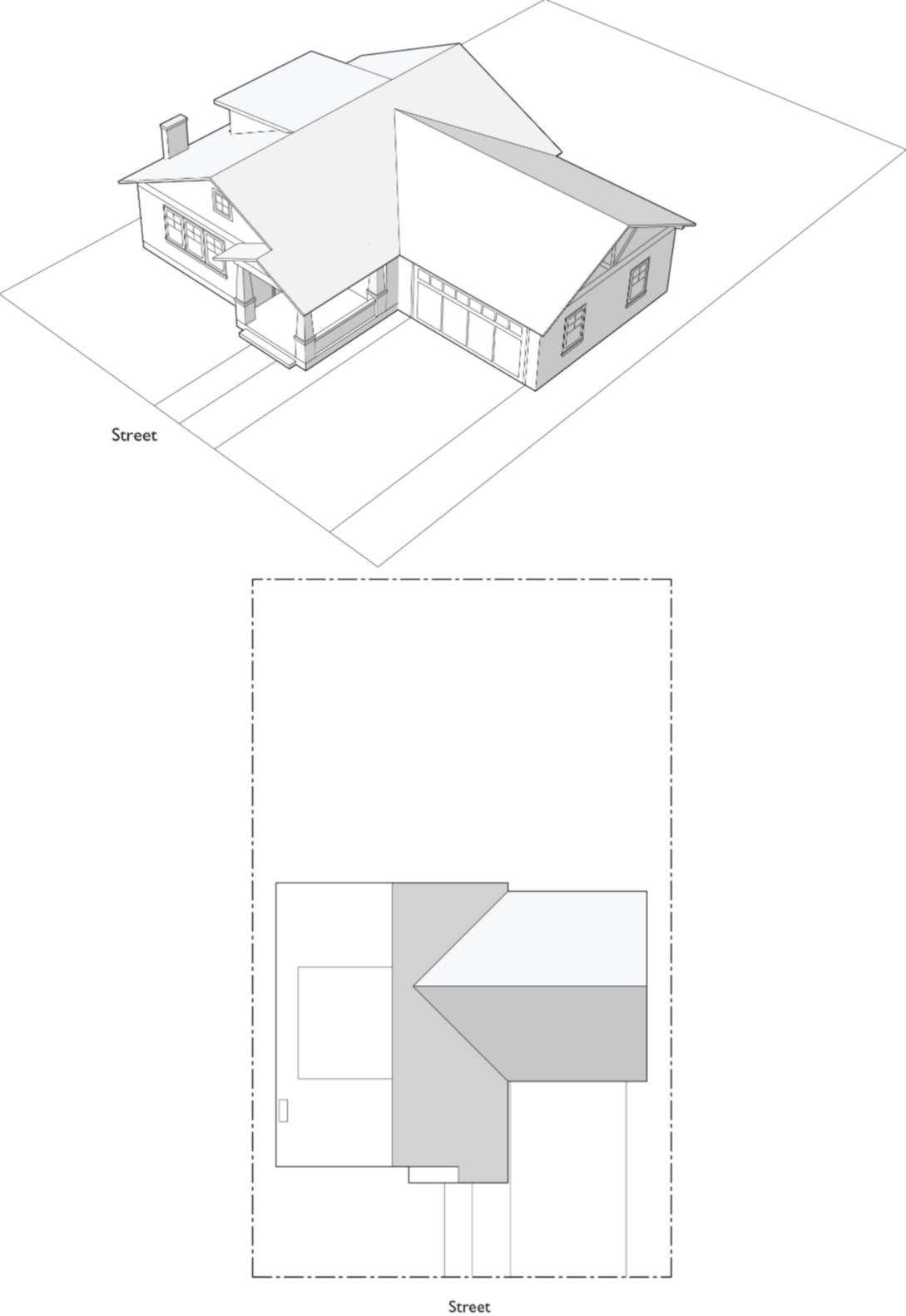
B. Accessory Dwelling Units. Accessory dwelling units are subject to the development standards and objective standards of the RS district, Sections 18.04.030, Development standards—RS districts, 18.04.040, Objetive design standards for RS districts, and 18.23.210, Accessory dwelling units/junior accessory dwelling units. The figures in this subsection illustrate accessory dwelling unit development standards and what resulting accessory dwelling unit development might look like.
FIGURE 18.04.070-B: RESIDENTIAL TYPES—ACCESSORY DWELLING UNITS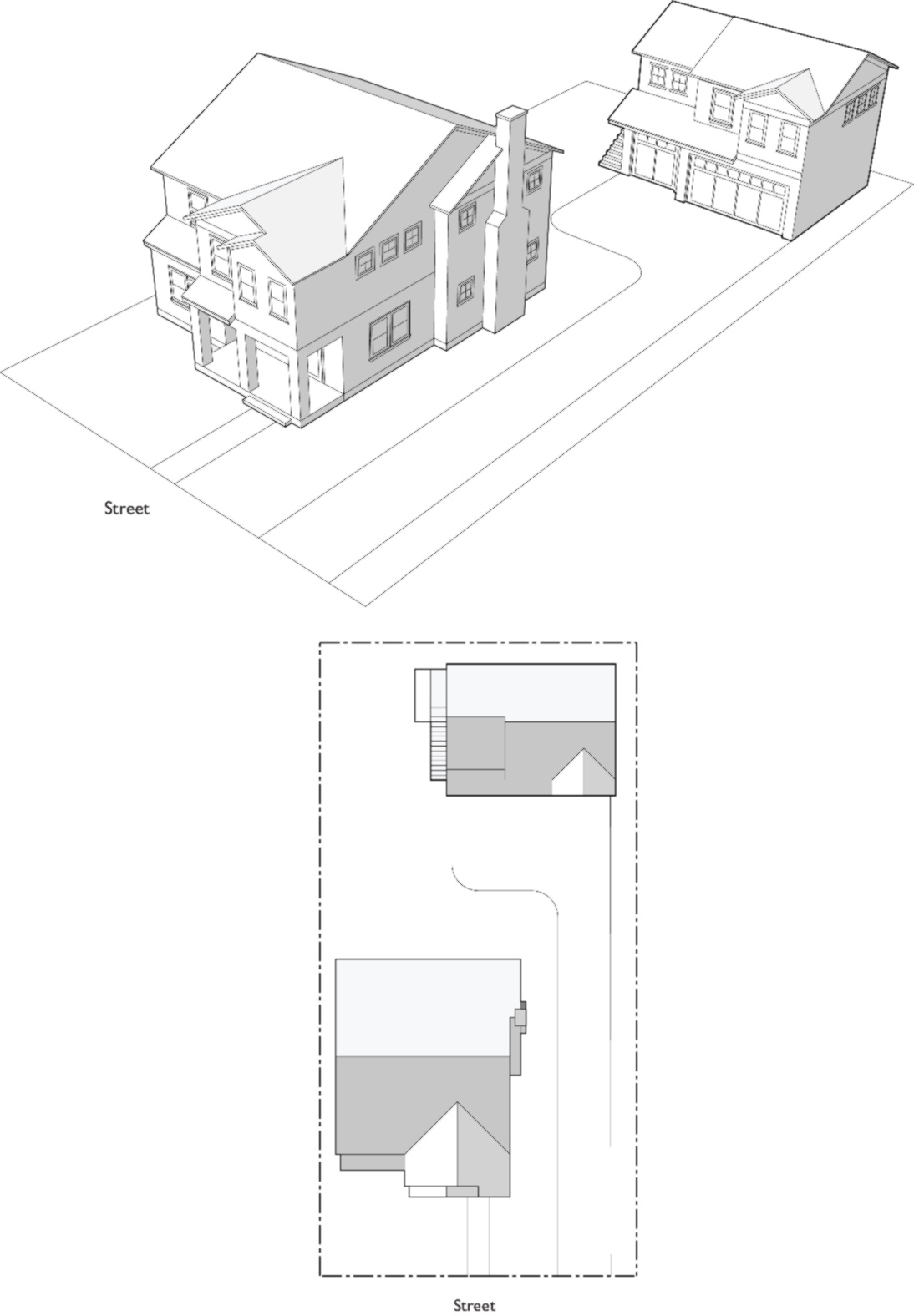
C. Small Lot Single-Unit Development. Small lot single-unit development is subject to the development standards and objective standards of the base district unless modified by Table 18.04.100-G. The figures in this subsection illustrate small lot single-unit development standards and what resulting development might look like.
D. Townhouse Development. Townhouse development is subject to the development standards and objective standards of the base district unless modified by Table 18.04.090-A. The figures in this subsection illustrate townhouse development standards and what resulting development might look like.
E. Duplex Development. Duplex development is subject to the development standards and objective standards of the base district unless modified by Section 18.04.080, Duplex standards. The figures in this subsection illustrate townhouse development standards and what resulting development might look like.
F. Urban Infill Units. Urban infill unit development is subject to the development standards and objective standards specified in Sections 18.23.310, Urban infill units, 18.04.030, Development standards—RS districts, 18.04.040, Objective design standards for RS districts, and 18.04.080, Duplex standards. (Ord. 1603 § 3 (Exh. A), 2023; Ord. 1596 § 6 (Exh. A), 2023; Ord. 1566 (Exh. B (part)), 2020; Ord. 1537 (Exh. B (part)), 2018: Ord. 1480 (Exh. B (part)), 2015; Ord. 1438 § 4 (Exh. A (part)), 2011)
18.04.080 Duplex standards.
Duplexes are subject to the development standards of the RS districts, specifically Section 18.04.030, Development standards—RS districts, unless modified by the standards specific to duplexes contained in this section. In the event of a conflict between the general standards for the RS districts and the standards specific to duplexes contained in this section, the standards in this section shall prevail.
FIGURE 18.04.080: TYPES—DUPLEX DEVELOPMENT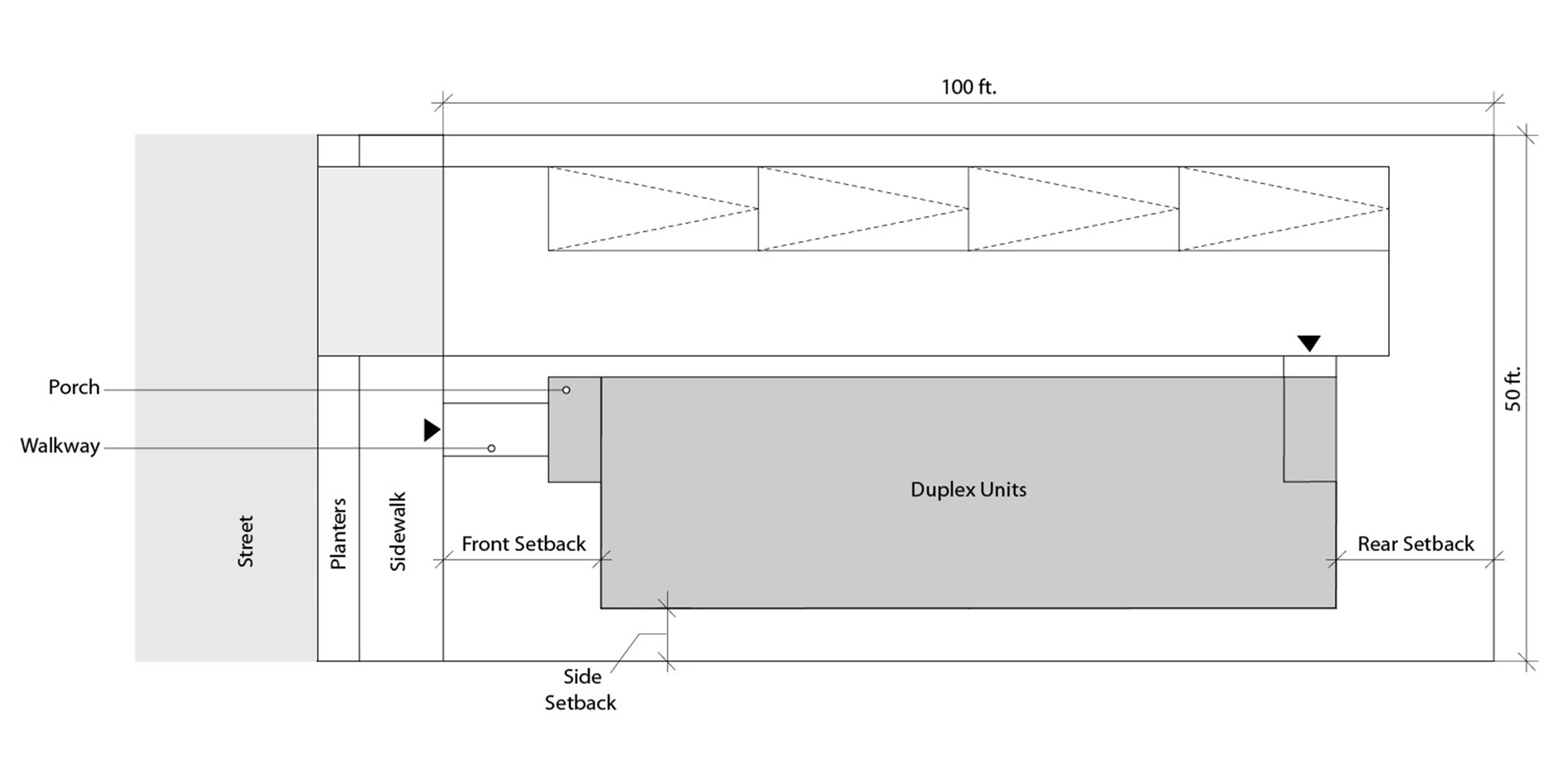
A. Overall Approach. The building design for duplexes shall be treated as a single building with unified massing and articulation to give the appearance of a single-unit development.
B. Building Height Within the Front and Rear Fifteen (15) Feet of the Building. The maximum height shall be measured as indicated in Section 18.03.050 (Measuring height), with no more than twenty-eight (28) feet to the highest point of the roof structure from the lowest finished grade. For buildings located in the Hillside Overlay Zoning District, refer to Chapter 18.12 (Hillside Overlay District).
C. Side Setback Exception. For lots less than fifty (50) feet in width, the minimum ground-floor side setback shall be a minimum of ten percent (10%) of the lot width or three (3) feet, whichever is greater.
D. Upper Story Alignment.
1. The upper story may align with the lower story at the required lower story five (5) foot setback up to thirty percent (30%) of the length of the lower story. The maximum thirty percent (30%) projection shall be measured from the rear wall of the lower story. Any window located on the projecting portion of the building shall be either a clerestory window or shall be glazed, tinted, etched, frosted, or treated in any similar manner that limits views into and from the window.
2. Where the ground floor is set back at least seven (7) feet from the property line, the upper story may align with the lower story for the entire length of the building.
E. Street Side Setbacks on Lots With Reversed Frontage. The exterior side setback in the rear twenty-five percent (25%) of a reversed corner lot shall not be less than the front yard required or existing, whichever is less, on the adjoining key lot.
FIGURE 18.04.080-E: STREET SIDE SETBACKS ON LOTS WITH REVERSED FRONTAGE—DUPLEX DEVELOPMENT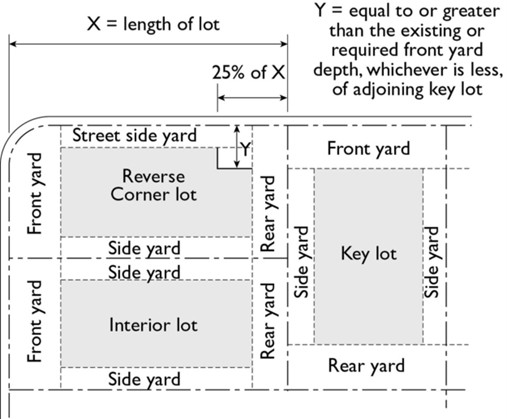
F. Objective Design Standards for Duplexes.
1. Site Planning.
a. Entry Location and Street Connectivity.
i. Entry Location. The principal entry to ground-floor, street-facing duplex units shall be located and oriented to face the adjacent public or private street.
(A) Street Connectivity. A separate walkway measuring minimum thirty-six (36) inches in width shall be provided to each ground-floor, street-facing duplex unit.
(B) The driveway shall not serve as the primary walkway to the building entry.
(C) The primary walkway shall be differentiated from the driveway with the use of paving materials. Differentiated paving materials may include but are not limited to pavers, stepping stones, flagstones, or gravel.
b. Parking and Driveways.
i. Parking/Garage Access. Parking spaces shall be provided as required by Chapter 18.20 (Parking and Loading).
ii. Driveways.
(A) Driveway approaches (curb cuts) shall be permitted only to provide access to approved garages, carports, and parking spaces.
(B) Curb cuts are permitted pursuant to Chapter 12.04 (Sidewalk and Driveway Approach Construction and Repair).
(C) Driveways up to twenty (20) feet wide are permitted to serve the primary unit. The minimum width of any driveway shall be ten (10) feet.
(D) Tandem parking configurations are permitted when only a single-car garage is proposed or existing. The driveway shall be a maximum of ten (10) feet wide and a maximum of thirty-eight (38) feet in length.
(E) Driveways abutting a side property line shall include a minimum three (3) foot wide pervious surface edge treatment along that abutting property line.
(F) Driveways must be distinguished from any front yard paving with a use of different color or material than the adjacent material in the front yard area.
(G) Driveways on corner lots shall be located at least twenty (20) feet from the property lines at the intersection corner.
(H) Driveways that provide access to the side or back of the building shall comply with current Building Division and Fire Department standards in adopted standards manuals.
c. Garage Frontage.
i. Where a garage is located on the front half of the lot and the garage door faces a street, the garage frontage, including the door width, shall not exceed fifty percent (50%) of the width of the front facade of the building.
ii. Garage doors facing the street shall have articulating elements consisting of at least one (1) of the following design elements on the facade:
(A) An overhang of at least eighteen (18) inches in depth.
(B) Windows.
(C) Have the garage door use colors or materials that are in the same color family as those of the primary building facade.
(D) Decorative trellis.
iii. The garage door shall not be more than twenty (20) feet wide.
iv. Side-loaded garages may be used to diminish the impact of garages along the street frontage. The use of at least one (1) of the following design elements is required to avoid the blank wall of the garage:
(A) Landscaping with a mature height of at least twenty-four (24) inches.
(B) Raised planters with a minimum height of twelve (12) inches and landscaping with a mature height of at least twelve (12) inches.
(C) Windows.
(D) Decorative trellis.
(E) Material change relative to materials used for the building.
v Detached Garages. Detached garages shall have a minimum setback of three (3) feet from a property line and four (4) feet from an alley.
d. Alley Access. A detached garage or carport is permitted to have access to the alley if all following conditions are achieved:
i. The garage or carport entrance shall be set back a minimum of four (4) feet from the alley;
ii. A forty-five (45) degree visibility triangle shall be provided on either side of the garage or carport; and
iii. The garage door shall not cross the property line when opening or closing.
FIGURE 18.04.080-F: ALLEY ACCESS—DUPLEX DEVELOPMENT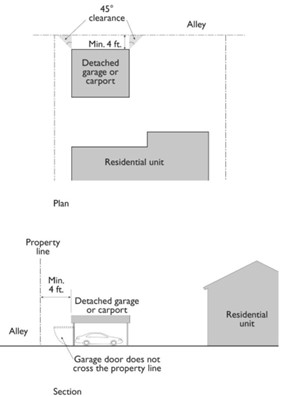
G. Building Design.
1. Massing. The purpose of regulating building mass is to ensure a building fits well on a site, respects the scale of the neighborhood, and avoids bulky appearance. Building walls and the massing of the duplex structure shall not run in a continuous plane of more than twenty-five (25) feet without one (1) or more of the following treatments:
a. Incorporate a change in wall plane with a minimum of four (4) feet in depth for the facade.
b. Provide a recessed entry of at least three (3) feet in depth.
c. Provide a protruding window (such as a bay window) of at least two (2) feet in depth.
d. Use at least two (2) distinct materials and colors on each facade (see subsection (H)(8) of this section, Materials).
e. Provide an upper story balcony in the front step back area.
2. Articulation. The purpose of regulating articulation is to avoid flat, blank walls that may result from the massing requirements as specified within the building design subsection and to create a visual interest to enhance the character of the neighborhood. The following regulations apply:
a. Facades. All facades on every floor shall not run in a continuous plane of more than fifteen (15) feet without one (1) of the following treatments included on the facade at every building story:
i. Window.
ii. Entry door (ground-floor only).
iii. Change in material (see subsection (H)(8) of this section, Materials).
iv. Decorative shutters.
v. Trellis.
b. Balconies.
i. Usable balconies shall not be located on any facade facing a side yard. Juliette/French balconies may be used as an accent feature on side yard facades, provided such balconies have a projection of no more than eighteen (18) inches.
ii. Projected and/or recessed balconies shall be at least four (4) feet deep and six (6) feet wide.
iii. Projected and/or recessed balconies located on rear facades shall not be located within fifteen (15) feet from any interior side property line.
iv. Projected and/or recessed balconies shall incorporate screening features that obstruct views into neighboring yards. Screening may be accomplished by architectural methods or by providing landscape screening along side-yard property lines. If landscape screening is provided without supporting elements, it shall comprise woody shrubs or trees that are at least fifteen (15) feet in height at installation and that will be less than eight (8) feet wide at maturity.
v. Projected balconies located on rear facades shall not encroach more than five (5) feet into the required rear setback.
3. Entryways. All ground-floor, street-facing units shall have an entryway defined by at least one (1) of the following elements:
a. Porch.
b. Recessed entry.
c. Deep overhang.
d. Stoops.
4. Entryway Treatments. Entryways shall be a characteristic component of the selected architectural style. The following standards shall apply to the selected treatment unless otherwise specified in the reference guide:
a. Porch Design.
i. The front porch facing the street shall be part of the primary entrance and connected to the front yard.
ii. Porches shall have a minimum depth of three (3) feet for up to thirty (30) square feet.
iii. Porches facing the street shall not encroach more than five (5) feet into the front setback.
iv. Porches facing the street shall not exceed ten (10) feet in height, as measured from the finished grade to the bottom of the eave, not including the roof element.
b. Recessed Entry.
i. Recessed entries facing the street shall be recessed at least three (3) feet from the building facade to create a covered landing area and to provide orientation toward the street.
ii. Recessed entries facing the street shall not exceed twelve (12) feet in height, not including the roof element.
c. Deep Overhang.
i. Deep overhangs facing the street shall be a minimum depth of three (3) feet and a maximum of five (5) feet.
ii. Deep overhangs facing the street shall not exceed twelve (12) feet in height, as measured from the finished grade to the top of the overhang, not including the roof element.
d. Stoops.
i. A stoop may be provided to each unit’s primary entrance or as a common entrance for both units.
ii. The stoop shall be of a minimum height of eighteen (18) inches.
5. Architectural Style.
a. For the purpose of defining architectural styles as set forth in this section, the reference guide shall be the most currently published version of A Field Guide to American Houses: the Definitive Guide to Identifying and Understanding America’s Domestic Architecture by Virginia Savage McAlester or American House Styles: A Concise Guide by John Milnes Baker, AIA. The City may identify an alternative source or sources, provided such source is made publicly available.
b. Using the building design reference document identified above, projects shall identify an architectural design style and include at least four (4) features in their design consistent with the description of the selected style:
i. Roof type and characteristic pitch (required).
ii. Roof rake, eave overhang, and cornice detail.
iii. Wall facade symmetry or asymmetry and detail.
iv. Wall material and arrangement relative to roof.
v. Window type, relative proportion, shape, and detail.
vi. Door type, relative proportion, shape, and detail.
vii. Porch type, relative proportion, shape, and detail.
c. Both duplex units shall have a consistent architectural style.
6. Roof Treatments.
a. Roof Form. Rooflines that are thirty (30) feet or longer along a street-facing property line and greater than fifty (50) linear feet for all other sides shall be articulated with at least one (1) of the following techniques:
i. Change in the roof ridge.
ii. Change in the shape of the roof.
iii. Change in the angle of the slope.
iv. Change in the eave depth.
v. Change in detailing in the form of dormers.
vi. Change in the detailing in the form of skylights.
b. Roof form articulation shall allow an exception where solar panels are to be provided. The applicant shall be required to provide documentation from a qualified designer or contractor citing specific building code requirements that necessitate the exception.
c. Roof Form Detail.
i. Sloped roofs shall incorporate a minimum of eight (8) inch deep eaves to create shadows and add depth to facades. If a particular style based on the architectural style subsection has a roof or eave style that is different from this standard, this standard shall not apply.
ii. Flat roofs, when used, shall incorporate a decorative cornice consistent with the architectural style selected, as specified in the cited reference book, and shall visually cap the building at a minimum of three (3) inches deep and twelve (12) inches tall.
d. Rooftop Utilities and Equipment. Rooftop utilities and equipment shall be screened by a parapet or mansard roof so that such equipment is not visible from the public right-of-way.
7. Windows.
a. Window Detail.
i. Window Trim or Recess. Trim at least one (1) inch in depth must be provided around all windows, or window must be recessed at least two (2) inches from the plane of the surrounding exterior wall. For double-hung and horizontal sliding windows, at least one (1) sash shall achieve a two (2) inch recess.
FIGURE 18.04.080-G: WINDOW DETAIL—DUPLEX DEVELOPMENT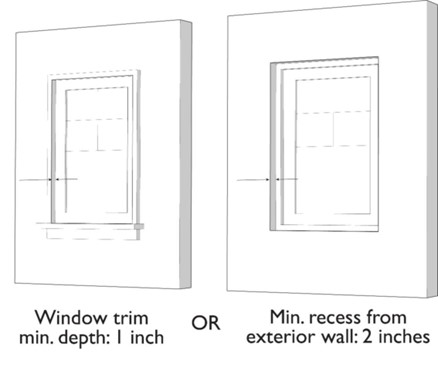
ii. Windows. Snap-in vinyl mullions between double pane glass are prohibited. If a divided light appearance is desired, mullions must be made of dimensional material projecting in front of the panes on both the inside and outside of the window.
8. Materials.
a. At a minimum, at least three (3) materials or colors shall be used consistently on the entire building facade and shall consist of materials appropriate to the selected architectural style (per architectural style reference guide) of the building. Roof and glazing material or color are excluded and do not count towards this requirement. The following building elements with materials and colors count towards this requirement:
i. Main building.
ii. Wainscoting.
iii. Trim work.
iv. Exterior doors.
v. Garage doors.
vi. Decorative elements including trellis, iron work, planter boxes, etc., each with a minimum of ten (10) square feet in surface area.
b. Where an exterior wainscoting is provided, such wainscoting shall have a minimum height of eighteen (18) inches from the finished grade. Wainscoting shall not end at the corner of the building but shall wrap around and continue at least eighteen (18) inches to provide a finished appearance.
c. The exterior use of porous materials, foam for trims, plastic, and plywood as siding materials is prohibited.
d. The Planning Director shall maintain a list of approved facade and trim materials, with such a list accessible to the public.
H. Other Details.
1. Landscape Design. The following standards are supplemental to the standards contained in Chapter 18.18 (Landscaping). Where conflicts exist, the stricter standard shall prevail.
a. Front Yard Landscaping.
i. Within the required front yard area, impermeable surfaces shall not exceed fifty percent (50%).
ii. At least fifty percent (50%) of the required front yard area shall consist of landscape as specified in Chapter 18.18 (Landscaping).
b. Front Yard Trees. The number of required trees shall be governed as specified in Section 18.18.070 (Trees).
2. Lighting. All exterior lighting shall comply with the provisions of Section 18.15.070 (Lighting and illumination). The following standards are supplemental to the existing standards and where conflicts exist, the stricter standard shall prevail.
a. Location. Any light fixture located along the pathways shall not obstruct ADA path of travel.
b. Brightness. Shall not exceed four hundred fifty (450) lumens per light fixture (equivalent to thirty (30) watt halogen light bulb) and should not exceed five (5) foot-candles in any given spot.
c. Direction. When using free standing light fixtures, the light elements shall be screened to minimize light spillage and confine light to site and directed away from neighbors.
i. All outdoor lighting, including in-ground lighting and parking area lights, shall be located and directed away from windows of residential units to reduce light impact on residents. All such lighting shall be directed downward and away from adjacent residences and public rights-of-way.
ii. To minimize the light glare and spillage all wall-mounted fixtures shall be oriented to an angle towards the ground. The optimal angle shall be between fifty (50) to seventy (70) degrees.
iii. Bollard lighting used to light walkways and other landscape features shall cast its light downward.
d. Security Lighting. Motion-activated security lighting shall not be capable of being activated by any person(s) in the public right-of-way or on adjacent property.
3. Utilities.
a. All utility screening shall comply with Section 18.15.090 (General site regulations).
b. Ground-level utilities and mechanical equipment directly serving the primary or secondary units shall not be located within any front yard area.
c. Public utilities equipment, where provided above ground, shall comply with the following:
i. Such equipment shall not be located within any required front setback area.
ii. Such equipment shall be screened using one (1) or more of the following approaches:
(A) Landscaping.
(B) Raised planters’ minimum height of twelve (12) inches with landscape.
(C) Mesh fence for vertical vegetation.
(D) Walls or fencing consistent with the overall architecture of the building. (Ord. 1603 § 3 (Exh. A), 2023)
18.04.090 Townhouse development.
A. Townhouse development shall be subject to the development standards and objective design standards of the base district unless modified by Table 18.04.090-A.
FIGURE 18.04.090: TOWNHOUSE DEVELOPMENT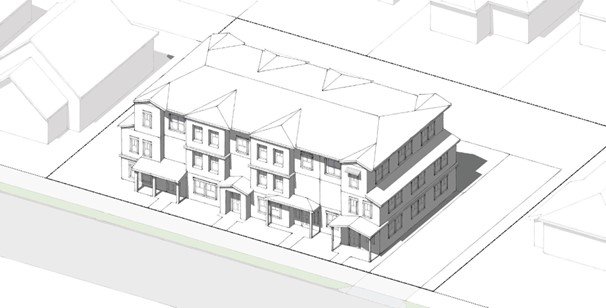
|
Standard |
Townhouse |
|---|---|
|
Site Standards |
|
|
Minimum Project Site Width |
80 ft. |
|
Maximum Project Site Floor Area Ratio (FAR) |
1.0 FAR |
|
Maximum Project Site Lot Coverage (percent of site) |
35% |
|
Building Height and Form |
|
|
Building Height—Maximum |
30 feet; see also Chapter 18.12 (Hillside Overlay District) |
|
Building Length—Maximum |
125 feet |
|
Setbacks (Minimums) |
|
|
Individual Lot |
|
|
Front |
10 ft. 5 ft. for porch |
|
Side (apply to the end of rows of attached units) |
1-story and 2-story portion: 4 ft. 3-story portions: 8 ft. Alternate—6 ft. setback with no stepbacks |
|
Rear |
15 ft.; 4 ft. for detached garage on alley |
|
Building Separation of Detached Units |
As required by Building and Fire Codes |
|
Parking and Access |
|
|
Garage Door Width—Maximum |
20 feet for garage facing the street |
|
Access Location |
Alley or side street where such is provided. For developments with no alley or side street, a single drive aisle of up to 10 feet width may provide access to garages. |
|
Building Orientation |
|
|
Orientation |
Facades shall be designed to orient towards the adjacent public street. |
|
Entrance Location |
The main entrance to each ground floor dwelling shall be visible to and located directly from the street. |
|
Usable Open Space |
|
|
Minimum Common and/or Private Open Space (percent of site) |
15% |
|
Minimum Horizontal Dimensions |
|
|
Ground Floor, Common |
20 ft. |
|
Ground Floor, Private |
10 ft. |
|
Balcony (ft.) |
The standards for the RS districts shall apply. |
|
Additional Standards |
|
|
Minimum Amount of Landscaping in the front yard (percent of site) |
50% |
|
Enclosed Personal Storage—Minimum required per unit |
80 cu. ft. To be located in individual garage units, provided a clear area of at least 400 sq. ft. is provided for the parking of vehicles. Alternatively, may be located in a central location or locations serving all units in the development. |
FIGURE 18.04.090-A: FRONT SETBACK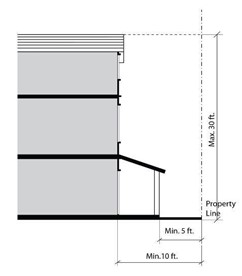
FIGURE 18.04.090-A: SIDE SETBACK—4 ft.
FIGURE 18.04.090-A: SIDE SETBACK—6 ft.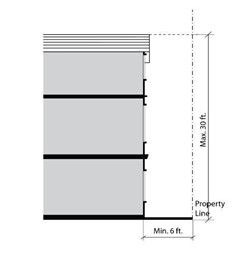
B. Building Height Within the Front and Rear Fifteen (15) Feet of the Building. The maximum height shall be measured as indicated in Section 18.03.050 (Measuring height), with no more than twenty-eight (28) feet to the highest point of the roof structure from the lowest finished grade. For buildings located in the Hillside Overlay Zoning District, refer to Chapter 18.12 (Hillside Overlay District).
C. Story Alignment.
1. The third story may align with the lower story at the required lower story four (4) foot setback up to thirty percent (30%) of the length of the lower story. The maximum thirty percent (30%) projection shall be measured from the rear wall of the lower story. Any window located on the projecting portion of the building shall be either a clerestory window or shall be glazed, tinted, etched, frosted, or treated in any similar manner that limits views into and from the window.
2. Where the ground floor is set back at least six (6) feet from the property line, the third story may align with the lower stories for the entire length of the building.
D. Objective Design Standards for Townhouse Developments.
1. Site Planning—Entry Location and Street Connectivity.
a. Entry Location.
i. Street-fronting townhouses shall be designed to orient to the adjacent public street.
ii. The main entrance to each street fronting townhouse unit shall be visible to and located directly off a street.
iii. Entrances to non-street fronting townhouse units shall be provided directly off a driveway, common courtyard, or common open space.
b. Street Connectivity.
i. A separate walkway measuring minimum thirty-six (36) inches in width shall be provided to the street fronting townhouses from the sidewalk to the primary entry.
ii. The driveway shall not serve as the primary walkway to the building entry.
iii. The primary walkway shall be differentiated from the driveway with the use of paving materials. Differentiated paving materials may include but are not limited to pavers, stepping stones, flagstones, or gravel.
2. Site Planning—Parking and Driveways.
a. Parking/Garage Access. Parking spaces shall be provided as required by Chapter 18.20 (Parking and Loading).
b. Driveways.
i. Driveway approaches (curb cuts) shall be permitted only to provide access to approved garages, carports, and parking spaces.
ii. Curb cuts are permitted pursuant to Chapter 12.04 (Sidewalk and Driveway Approach Construction and Repair).
iii. Driveways up to twenty (20) feet wide are permitted to serve the primary unit.
iv. Tandem parking configurations are permitted when only a single-car garage is proposed or existing. The driveway shall be a maximum of ten (10) feet wide and a maximum of thirty-eight (38) feet in length.
v. Driveways abutting a side property line shall include a minimum three (3) foot wide pervious surface edge treatment along that abutting property line.
vi. Driveways must be distinguished from any front yard paving with a use of different color or material than the adjacent material in the front yard area.
vii. Driveways on corner lots shall be located at least twenty (20) feet from the property lines at the intersection corner.
viii. Driveways that provide access to the side or back of the building shall comply with current Building Division and Fire Department standards in adopted standards manuals.
3. Site Planning—Garage Frontage.
a. Where a garage is located on the front half of the lot and the garage door faces a street, the garage frontage, including the door width, shall not exceed fifty percent (50%) of the width of the front facade of the building.
b. Garage doors facing the street shall have articulating elements consisting of at least one (1) of the following design elements on the facade:
i. An overhang of at least eighteen (18) inches in depth.
ii. Windows.
iii. Have the garage door use colors or materials that are in the same color family as those of the primary building facade.
iv. Decorative trellis.
c. The garage door shall not be more than twenty (20) feet wide.
d. Side-loaded garages may be used to diminish the impact of garages along the street frontage. The use of at least one (1) of the following design elements is required to avoid the blank wall of the garage:
i. Landscaping with a mature height of at least twenty-four (24) inches.
ii. Raised planters with a minimum height of twelve (12) inches and landscaping with a mature height of at least twelve (12) inches.
iii. Windows.
iv. Decorative trellis.
v. Material change relative to materials used for the building.
4. Building Design—Massing. The purpose of regulating building mass is to ensure a building fits well on a site, respects the scale of the neighborhood, and avoids bulky appearance. Building walls and the massing of the structure shall not run in a continuous plane of more than twenty-five (25) feet without one (1) or more of the following treatments:
a. Incorporate a change in wall plane with a minimum of four (4) feet in depth for the facade.
b. Provide a recessed entry of at least three (3) feet in depth.
c. Provide a protruding window (such as a bay window) of at least two (2) feet in depth.
d. Use at least two (2) distinct materials and colors on each facade (see subsection (D)(5)(j) of this section, Materials).
e. Provide an upper story balcony, where allowed, in the front stepback area.
5. Building Design—Articulation. The purpose of regulating articulation is to avoid flat, blank walls that may result from massing requirements as indicated within the building design subsection and to create a visual interest to enhance the character of the neighborhood. The following regulations apply:
a. All facades on every floor shall not run in a continuous plane of more than ten (10) feet without one (1) of the following treatments included on the facade at every building story:
i. Window.
ii. Entry door (ground-floor only).
iii. Change in material (see subsection (D)(5)(j) of this section, Materials).
iv. Decorative shutters.
v. Trellis.
b. Townhouse developments shall be designed and constructed so that each individual residential unit is clearly distinguishable as a distinct living unit. This shall be accomplished by using two (2) or more of the following approaches:
i. A change in the front facade wall plane to a minimum depth of two (2) feet for each unit, if three (3) or more units are combined.
ii. Use of colors and building materials that are different from but complementary to those used on each attached unit on either side.
iii. A change in roof pitch for individual units.
iv. A change in door color and/or door materials relative to each attached unit on either side.
v. Use of front door overhangs that vary from unit to unit.
vi. Use of stoop materials that are different than those used on each attached unit on either side.
FIGURE 18.04.090-D(5)(b): BUILDING DESIGN—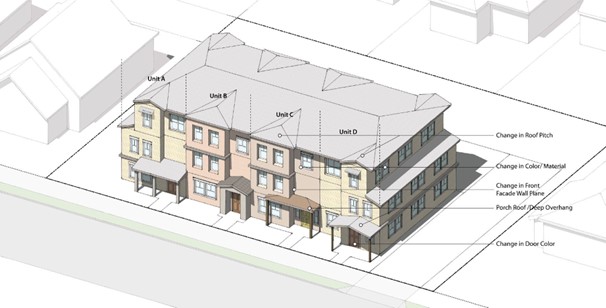 TOWNHOUSE DEVELOPMENT
TOWNHOUSE DEVELOPMENT
c. Side and rear facades shall have windows and facade treatments that match those on the front facade of that unit.
d. Balconies.
i. Usable balconies shall not be located on any facade facing a side yard. Juliette/French balconies may be used as an accent feature on side yard facades, provided such balconies have a projection of no more than eighteen (18) inches.
ii. Usable balconies shall not be provided on the third story.
iii. Balconies can be proposed in the front facing the street or in the rear setback area. Balconies can encroach into the setback area to a maximum of four (4) feet.
iv. Projected and/or recessed balconies shall be at least four (4) feet of depth and six (6) feet of length.
v. Projected and/or recessed balconies located on rear facades shall not be located within fifteen (15) feet from any interior side property line.
vi. Projected and/or recessed balconies shall incorporate screening features that obstruct views into neighboring yards. Screening may be accomplished by architectural methods or by providing landscape screening along side-yard property lines. If landscape screening is provided without supporting elements, it shall comprise woody shrubs or trees that are at least fifteen (15) feet in height at installation and that will be less than eight (8) feet wide at maturity.
vii. Patios on the ground floor facing the side yard are allowed and shall be screened from neighboring units. These balconies/patios spaces may count towards private open space requirement.
e. Entryways. All townhouse development units shall have an entryway facing the street defined by at least one (1) of the following elements unless otherwise specified in the reference guide:
i. Porch.
ii. Recessed entry.
iii. Deep overhang.
iv. Elevated stoop.
FIGURE 18.04.090-D(5)(e): BUILDING DESIGN—ENTRYWAYS—TOWNHOUSE DEVELOPMENT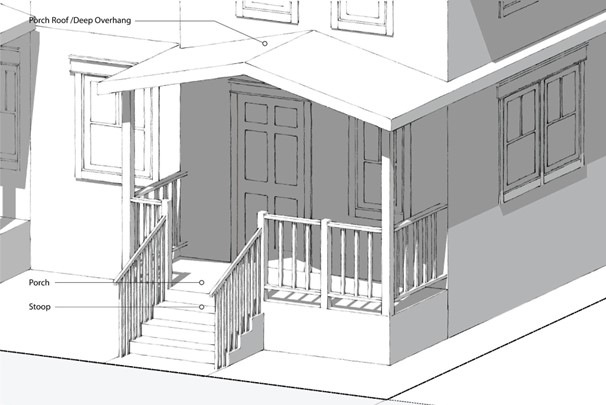
f. Entryway Treatments. Entryways shall be a characteristic component of the selected architectural style unless otherwise specified in the reference guide. The following standards shall apply.
i. Porch Design.
(A) The front porch facing the street shall be part of the primary entrance and connected to the front yard.
(B) Porches facing the street shall have a minimum depth of three (3) feet for up to thirty (30) square feet.
(C) Porches facing the street shall not encroach more than three (3) feet into the front setback.
(D) Porches facing the street shall not exceed ten (10) feet in height measured from the finished grade to the bottom of the eave, not including the roof element.
ii. Recessed Entry.
(A) Recessed entries facing the street shall be recessed at least three (3) feet from the building facade to create a covered landing area and to provide orientation toward the street.
(B) Recessed entries facing the street shall not exceed twelve (12) feet in height, not including the roof element.
iii. Deep Overhang.
(A) Deep overhangs facing the street shall be a minimum depth of three (3) feet and a maximum of five (5) feet.
(B) Deep overhangs facing the street shall not exceed twelve (12) feet in height measured from the finished grade to the top of the overhang, not including the roof element.
iv. Stoops.
(A) Individual stoops shall be provided for each unit.
(B) The stoop shall have a minimum height of two (2) feet.
g. Architectural Style.
i. For the purpose of defining architectural styles as set forth in this section, the reference guide shall be the most currently published version of A Field Guide to American Houses: the Definitive Guide to Identifying and Understanding America’s Domestic Architecture by Virginia Savage McAlester or American House Styles: A Concise Guide by John Milnes Baker, AIA. The City may identify an alternative source or sources, provided such source is made publicly available.
ii. Using the building design reference document identified above, projects shall identify an architectural design style and include at least four (4) features in their design consistent with the description of the selected style:
(A) Roof type and characteristic pitch (required).
(B) Roof rake, eave overhang, and cornice detail.
(C) Wall facade symmetry or asymmetry and detail.
(D) Wall material and arrangement relative to roof.
(E) Window type, relative proportion, shape, and detail.
(F) Door type, relative proportion, shape, and detail.
(G) Porch type, relative proportion, shape, and detail.
iii. All attached townhome units shall have a consistent architectural style.
h. Roof Treatments.
i. Roof Form. Rooflines that are thirty (30) feet or longer along a street-facing property line and greater than fifty (50) linear feet for all other sides shall be articulated with at least one (1) of the following techniques:
(A) Change in the roof ridge.
(B) Change in the shape of the roof.
(C) Change in the angle of the slope.
(D) Change in the eave depth.
(E) Change in detailing in the form of dormers.
(F) Change in the detailing in the form of skylights.
ii. Roof form articulation shall allow an exception where solar panels are to be provided. The applicant shall be required to provide documentation from a qualified designer or contractor citing specific building code requirements that necessitate the exception.
iii. Roof Form Detail.
(A) Sloped roofs shall incorporate a minimum of eight (8) inch deep eaves to create shadows and add depth to facades. If a particular style based on the architectural style subsection has a roof or eave style that is different from this standard, this standard shall not apply.
(B) Flat roofs, when used, shall incorporate a decorative cornice consistent with the architectural style as specified in the cited reference book and shall visually cap the building at a minimum of three (3) inches deep and twelve (12) inches tall.
iv. Roof-top Utilities and Equipment. Rooftop utilities and equipment shall be screened by a parapet or mansard roof so that such equipment is not visible from the public right-of-way.
i. Windows.
i. Window Detail.
(A) Window Trim or Recess. Trim at least one (1) inch in depth must be provided around all windows, or window must be recessed at least two (2) inches from the plane of the surrounding exterior wall. For double-hung and horizontal sliding windows, at least one (1) sash shall achieve a two (2) inch recess.
FIGURE 18.04.090-D(5)(i): WINDOW DETAIL—TOWNHOUSE DEVELOPMENT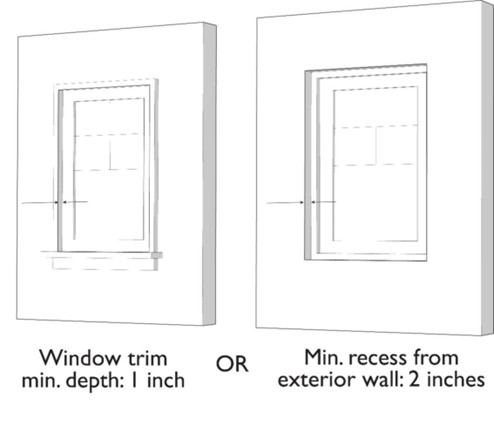
(B) Windows. Snap-in vinyl mullions between double pane glass are prohibited. If a divided light appearance is desired, mullions must be made of dimensional material projecting in front of the panes on both the inside and outside of the window.
j. Materials.
i. At a minimum, at least three (3) materials or colors shall be used consistently on the entire building facade and shall consist of materials appropriate to the selected architectural style (per architectural style reference guide) of the building. Roof and glazing material or color are excluded and do not count towards this requirement. The following building elements with materials and colors count towards this requirement:
(A) Main building.
(B) Wainscoting.
(C) Trim work.
(D) Exterior doors.
(E) Garage doors.
(F) Decorative elements including trellis, iron work, planter boxes, etc., each with a minimum of ten (10) square feet in surface area.
(G) Building entrances, including porch and stoop.
ii. Where an exterior wainscoting is provided, such wainscoting shall have a minimum height of eighteen (18) inches from the finished grade. Wainscoting shall not end at the corner of the building but shall wrap around and continue at least eighteen (18) inches to provide a finished appearance.
iii. The exterior use of porous materials, foam for trims, plastic, and plywood as siding materials is prohibited.
iv. The Planning Director shall maintain a list of approved facade and trim materials, with such a list accessible to the public.
6. Other Details.
a. Landscape Design. The following standards are supplemental to the standards contained in Chapter 18.18 (Landscaping). Where conflicts exist, the stricter standard shall prevail.
i. Front Yard and Rear Yard Landscaping.
(A) Within the required front yard and rear yard area, impermeable surfaces shall not exceed fifty percent (50%).
(B) At least fifty percent (50%) of the required front yard and rear yard areas shall consist of landscape materials as specified in Chapter 18.18 (Landscaping).
(C) Front yard and rear yard landscaping may count towards the private/public open space requirement.
ii. Front Yard Trees. The number of required trees shall be governed as specified in Section 18.18.070 (Trees).
b. Lighting. All exterior lighting shall comply with the provisions of Section 18.15.070 (Lighting and illumination). The following standards are supplemental to the existing standards and where conflicts exist, the stricter standard shall prevail.
i. Location. Any light fixture located along the pathways shall not obstruct ADA path of travel.
ii. Brightness. Shall not exceed four hundred fifty (450) lumens per light fixture (equivalent to thirty (30) watt halogen light bulb) and should not exceed five (5) foot-candles in any given spot.
iii. Direction. When using freestanding light fixtures the light elements shall be screened to minimize light spillage and confine light to site and directed away from neighbors.
(A) All outdoor lighting, including in-ground lighting and parking area lights, shall be located and directed away from windows of residential units to reduce light impact on residents. Such lighting shall be directed downward and away from adjacent residences and public rights-of-way.
(B) To minimize the light glare and spillage all wall-mounted fixtures shall be oriented to an angle towards the ground. The optimal angle shall be between fifty (50) to seventy (70) degrees.
(C) Bollard lighting used to light walkways and other landscape features shall cast its light downward.
iv. Security Lighting. Motion-activated security lighting shall not be capable of being activated by any person(s) in the public right-of-way or on adjacent property.
c. Utilities.
i. All utility screening shall comply with Section 18.15.090 (Screening).
ii. Ground-level utilities and mechanical equipment directly serving the townhome units shall not be located within any front or rear yard area.
iii. Public utilities equipment, where provided above ground, shall comply with the following:
(A) Such equipment shall not be located within any required front setback area.
(B) Such equipment shall be screened using one (1) or more of the following approaches:
(1) Landscaping.
(2) Raised planters’ minimum height of twelve (12) inches with landscape.
(3) Mesh fence for vertical vegetation.
(4) Walls or fencing consistent with the overall architecture of the building. (Ord. 1603 § 3 (Exh. A), 2023)
18.04.100 Small lot subdivisions.
A. Purpose. The purpose of this section is to provide opportunities to increase the supply of smaller dwelling units and rental housing units by allowing the creation of subdivisions with smaller lots and dwellings. It also is intended to establish design and development standards for these projects to ensure that they are compatible with the surrounding neighborhood, where the general plan anticipates no change to existing neighborhood character.
B. Location. A small lot subdivision may be proposed and approved on any site within the RS district where such development would be compatible with adjacent uses and the character of the area. A small lot subdivision shall not be allowed where the review authority determines that public utilities and services are inadequate or the landform is inappropriate for such development because of grading or impacts on views from adjacent lots.
C. Development Types. Small lot subdivisions may be proposed and approved for small lot single-unit subdivisions, and townhouse development developed according to Section 18.04.070, Residential development types.
D. Lot Standards. The lot standards listed in Table 18.04.100-D, Small Lot Subdivision Lot Standards, apply to small lot subdivisions.
FIGURE 18.04.100: BUILDING DESIGN—SMALL LOT SUBDIVISION DEVELOPMENT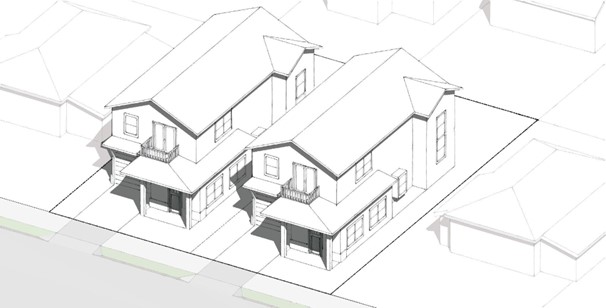
|
Standard |
Small Lot |
Townhouse |
|---|---|---|
|
Minimum Lot Size (sq. ft.) |
2,000 |
n/a |
|
Minimum Lot Width (ft.) |
30 |
20 |
E. Permit Requirement. A proposed small lot subdivision shall require the approval of a conditional use permit in compliance with Chapter 18.30, Use Permits, and a tentative map in compliance with the subdivision ordinance.
F. Required Findings. In addition to standard use permit findings, the review authority must find that the development is compatible with the neighborhood and that dwellings are proportionate to the lot size.
G. Applicable Development Standards. Small lot single-unit development projects shall conform with the development standards and objective design standards of the base district unless modified by Table 18.04.100-G.
|
Standard |
Small Lot Single-Unit |
|---|---|
|
Site Standards |
|
|
Minimum Project Site Width |
80 feet |
|
Maximum Project Site Floor Area Ratio (FAR) |
0.45 |
|
Maximum Project Site Lot Coverage (percent of site) |
35% |
|
Building Height and Form |
|
|
Maximum Height |
28 feet See also Chapter 18.12 (Hillside Overlay District) |
|
Maximum Building Length (ft.) |
n/a |
|
Setbacks |
|
|
Project Site |
The overall project site is subject to the setback requirements of the base district. |
|
Individual Lot |
|
|
Front |
10 ft.; 5 ft. for porch |
|
Side |
1- and 2-story portion: 4 ft. 3-story portion: 8 ft. Alternative: 6-ft. side setback for entire building with no stepbacks |
|
Rear |
15 ft.; 4 ft. for detached garage on alley |
|
Building Separation of Detached Units |
5 ft. |
|
Parking and Access |
|
|
Garage Behind Primary Facade |
5 ft. |
|
Maximum Garage Width |
20 ft.; common garages not visible from the street may accommodate up to four cars. |
|
Access Location |
Alley or side street wherever possible. |
|
Building Orientation |
|
|
Orientation |
Facades shall be designed to orient towards the public street. |
|
Entrance Location |
The main entrance to each ground floor dwelling shall be visible to and located directly off the street. |
|
Usable Open Space |
|
|
Minimum Common and/or Private Open Space (percent of site area) |
15% |
|
Minimum Horizontal Dimensions |
|
|
Ground Floor, Common (ft.) |
20 |
|
Ground Floor, Private (ft.) |
10 |
|
Balcony (ft.) |
Same as RS standards |
|
Additional Standards |
|
|
Minimum Amount of Landscaping in the Front Yard (percent of site) |
50% |
|
Minimum Amount of Enclosed Personal Storage (sq. ft.) |
80 |
FIGURE 18.04.100-G: FRONT SETBACK
FIGURE 18.04.100-G: SIDE SETBACK—4 ft.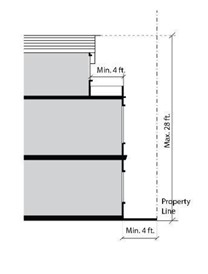
FIGURE 18.04.100-G: SIDE SETBACK—6 ft.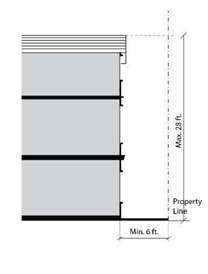
(Ord. 1603 § 3 (Exh. A), 2023)



